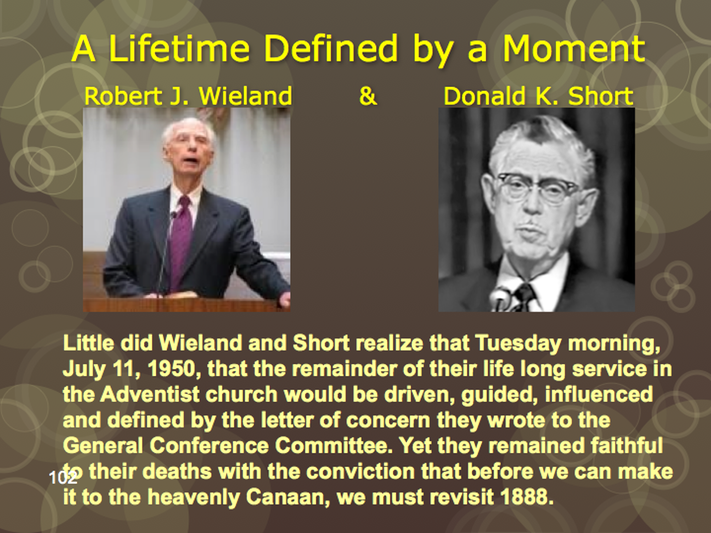
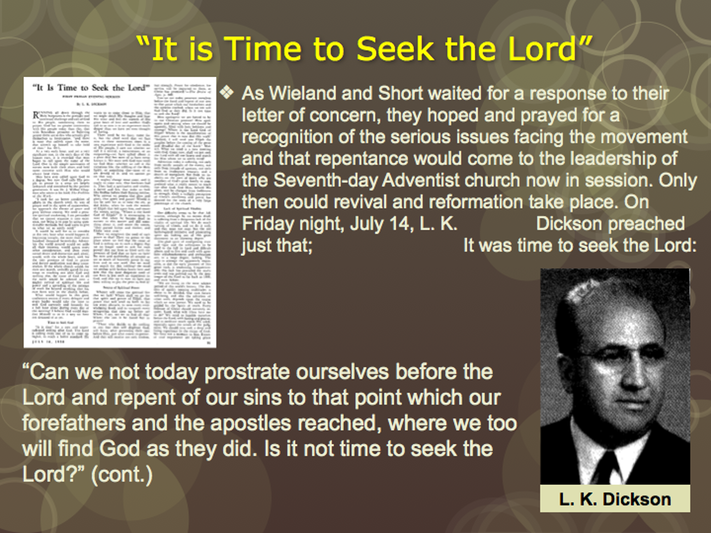
1 of 3 Slides.
“Elder Dickson, to whom has been assigned this first preaching hour of the Sabbath [Friday night], confronts us squarely with the challenge and gravity of the times and developments to which we have come.” (Carlyle B. Haynes, “Sabbath, July 15,” Review and Herald, July 16, 1950, p. 89)
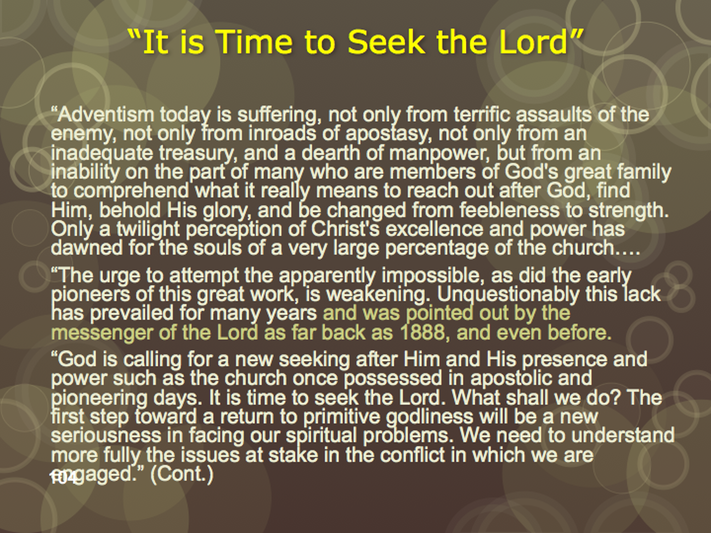
2 of 3 Slides.
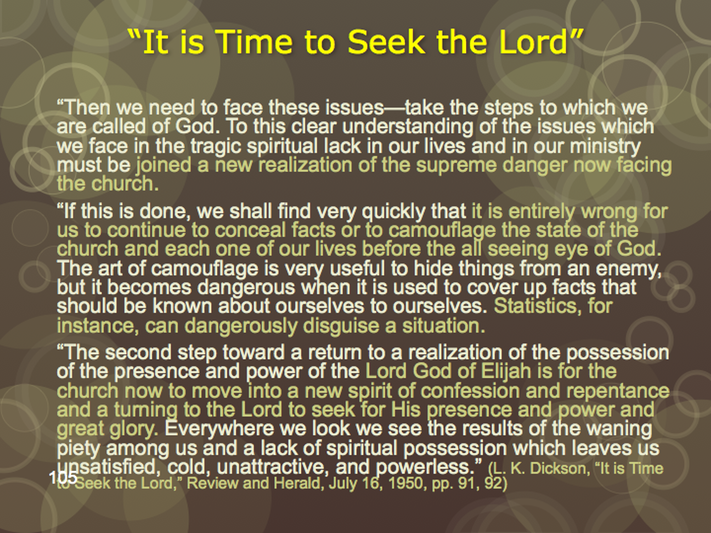
3 of 3 Slides.
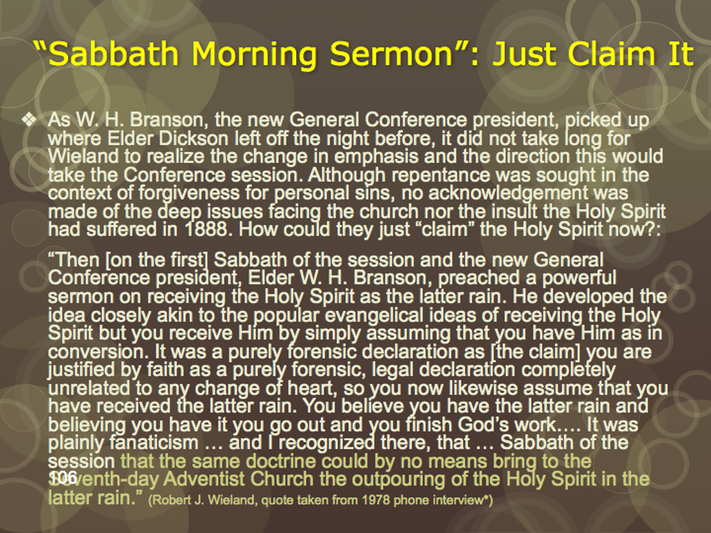
*(Robert J. Wieland, in Bradley Roy Williams, “Robert J. Wieland Before 1888 Re-examined, and Some of His Effect on Adventists,” A Report Presented in Partial Fulfillment of the Requirements for the Course CHIS 574, Development of Seventh-day Adventist Theology, Andrews University, Autumn 1978, Appendix K, “Wieland, Pre-1950,” pp. 20, 21; http://www.andrews.edu/library/car/cardigital/digitized/documents/b10122114.pdf, accessed Oct. 2014)
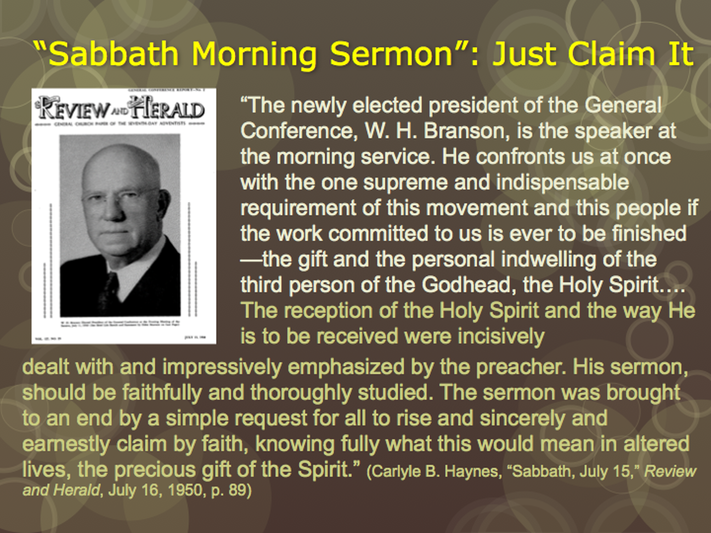
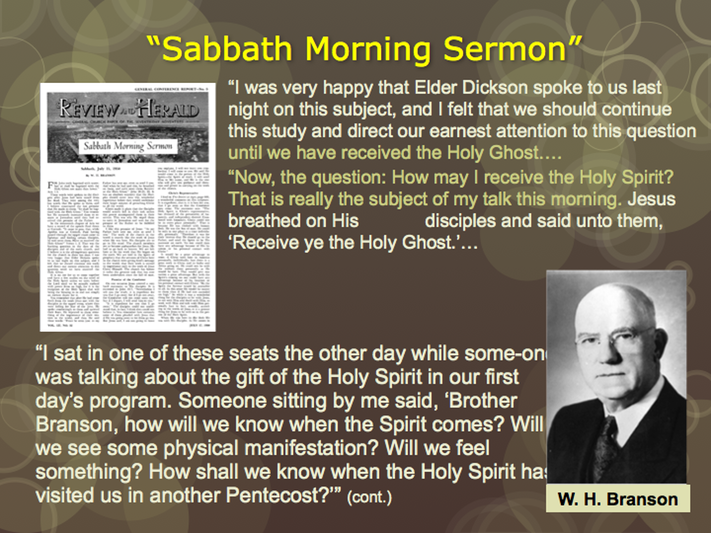
1 of 4 Slides.
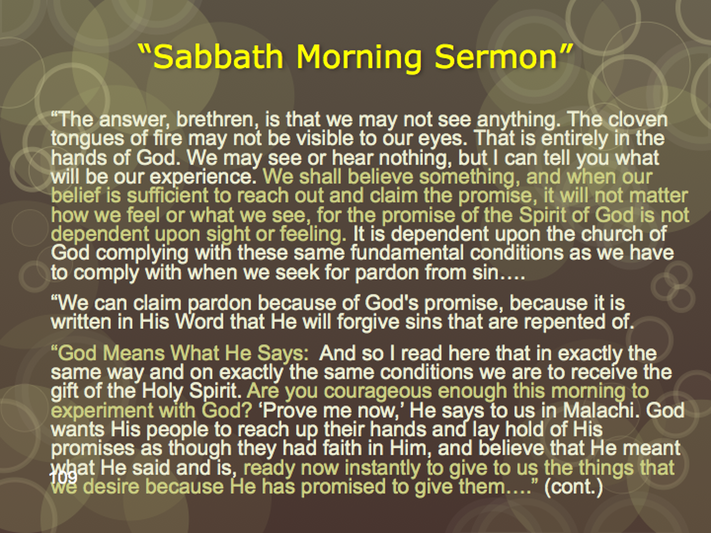
2 of 4 Slides.
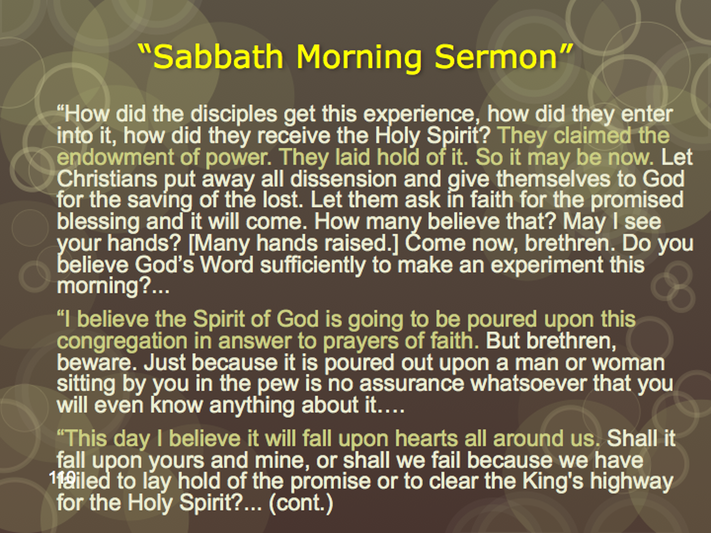
3 of 4 Slides.
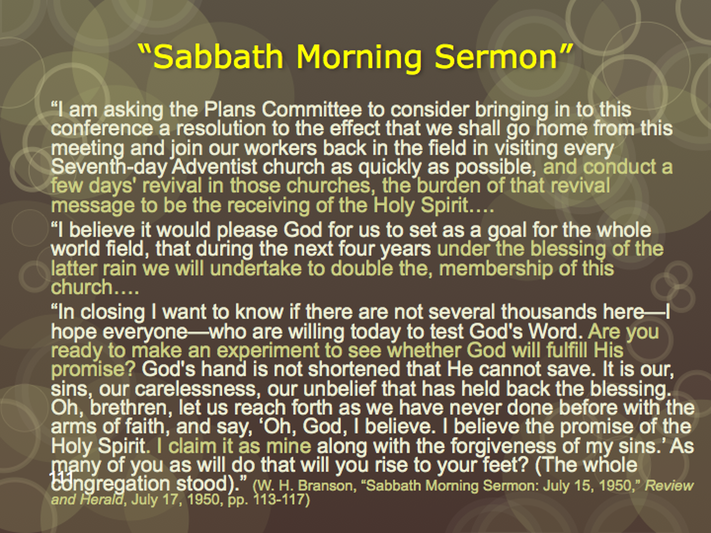
4 of 4 Slides.
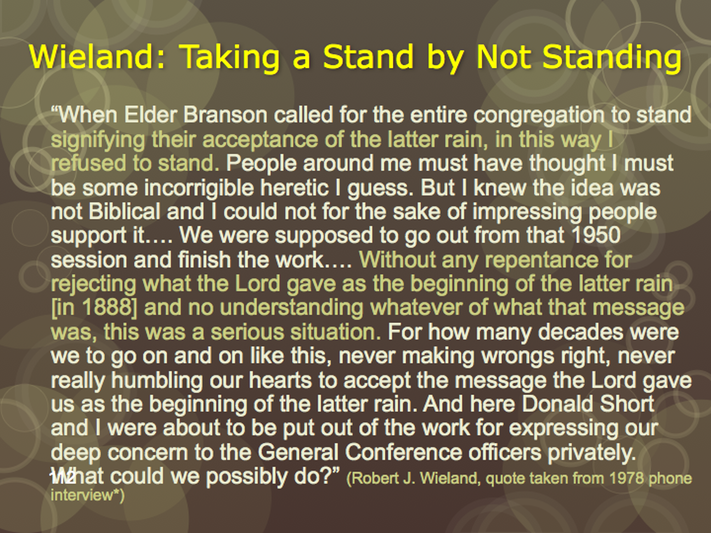
*(Robert J. Wieland, in Bradley Roy Williams, “Robert J. Wieland Before 1888 Re-examined, and Some of His Effect on Adventists,” A Report Presented in Partial Fulfillment of the Requirements for the Course CHIS 574, Development of Seventh-day Adventist Theology, Andrews University, Autumn 1978, Appendix K, “Wieland, Pre-1950,” pp. 20, 21; http://www.andrews.edu/library/car/cardigital/digitized/documents/b10122114.pdf, accessed Oct. 2014)
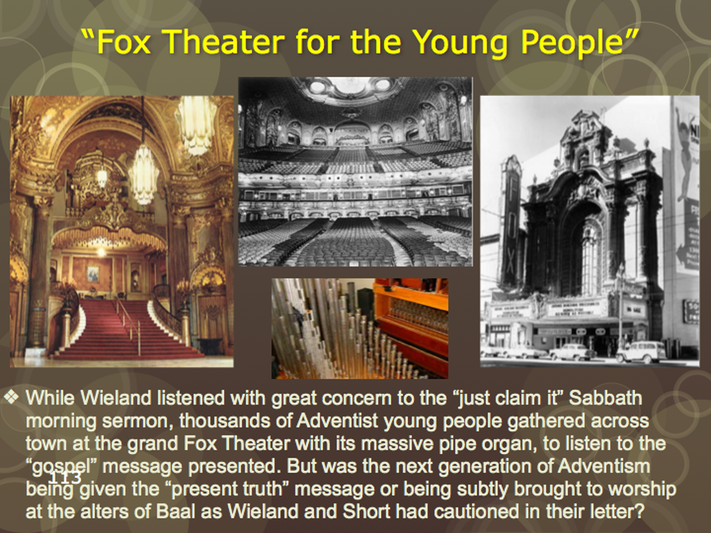
http://cinemagumbo.squarespace
http://transbayblog.com/2009/02/02/21st-century-fox/.com/journal/tag/fox-theater
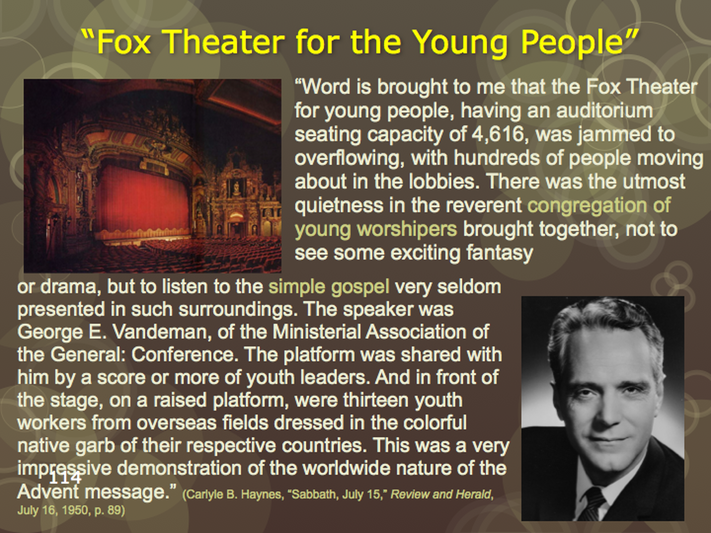
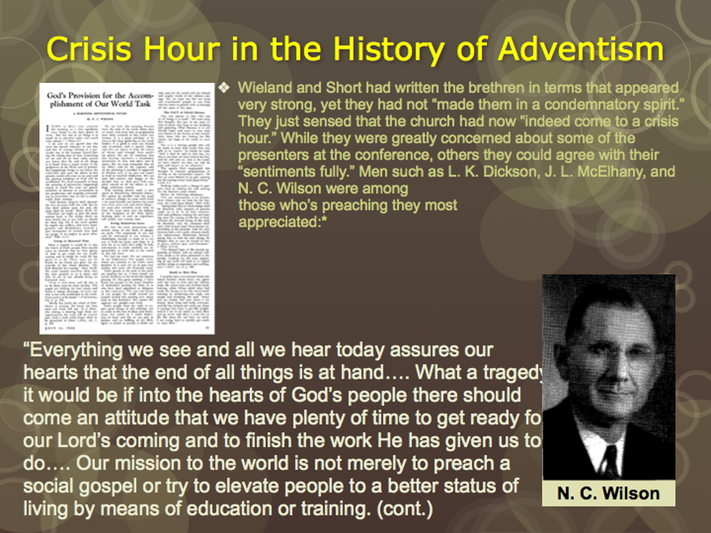
1 of 3 Slides
* (Robert J. Wieland and Donald K. Short, Faith on Trial, p. 68)
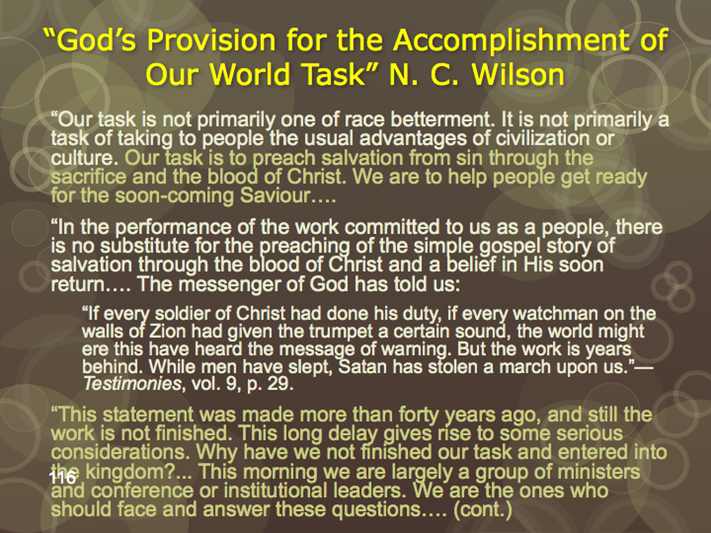
2 of 3 Slides.
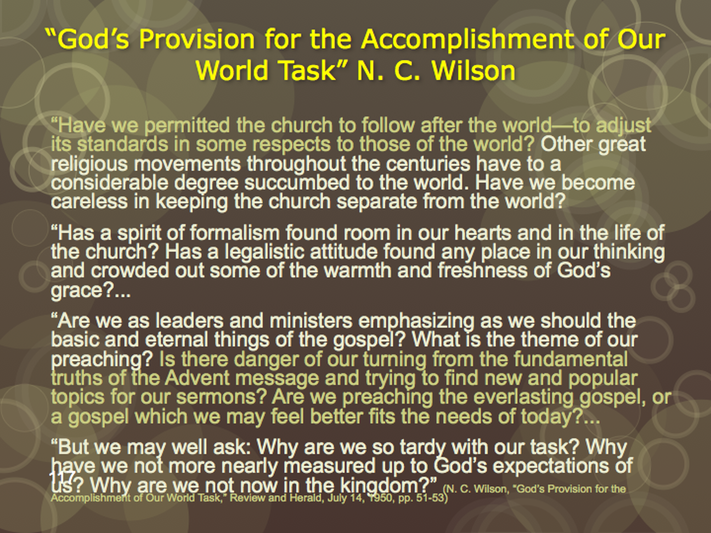
3 of 3 Slides.
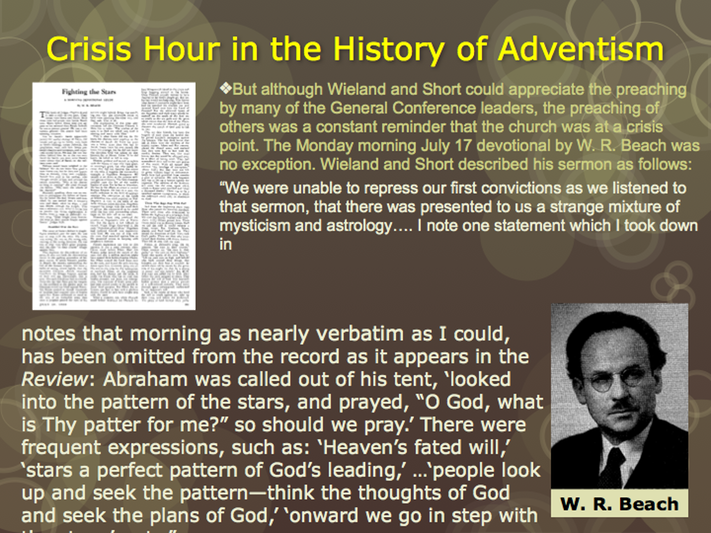
1 of 3 Slides.
Wieland and Short actually wrote a letter to the General Conference over their concern for this morning devotional, but never delivered it since they still had not heard back in regard to their first letter of concern submitted on the opening day of the General Conference (ibid., p. 68)
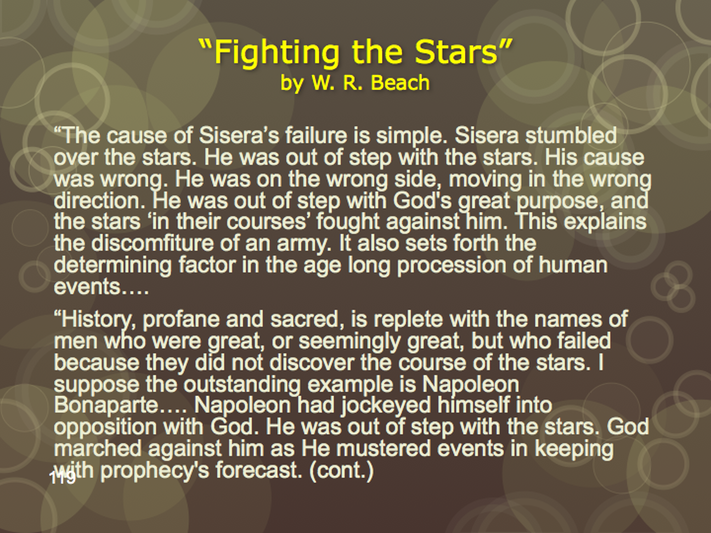
2 of 3 Slides.
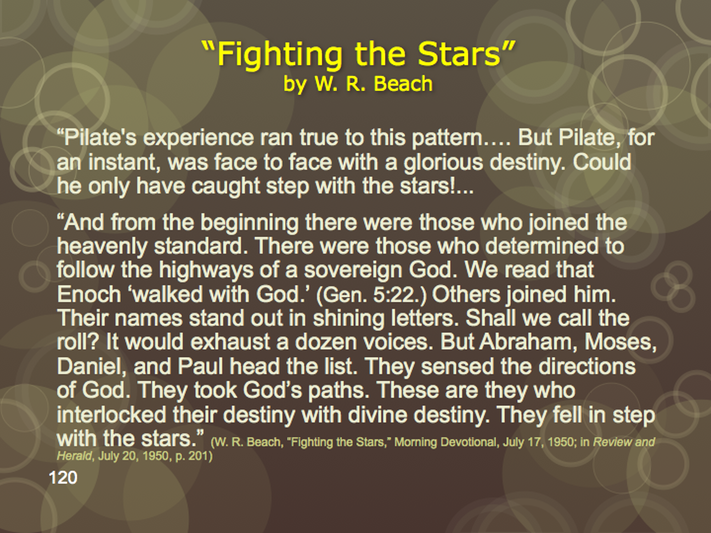
3 of 3 Slides.
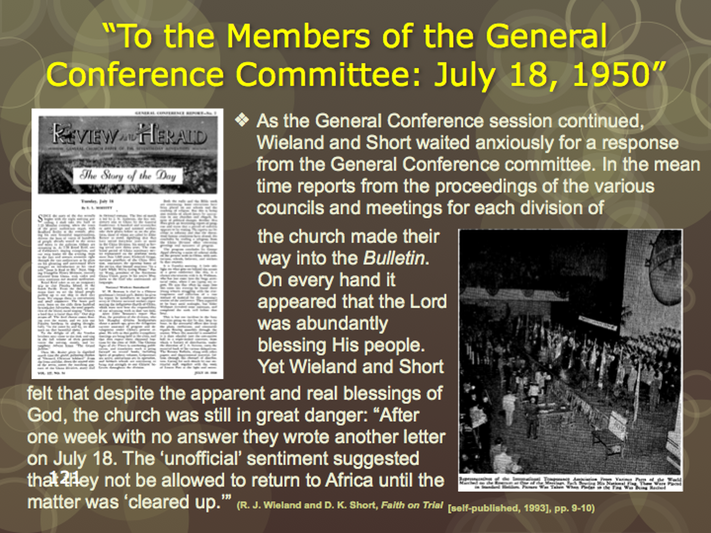
http://documents.adventistarchives.org/Periodicals/GCSessionBulletins/GCB1950-07.pdf
The second letter was delivered Tuesday, July 18, 1950, with only 4 days remaining of the General Conference
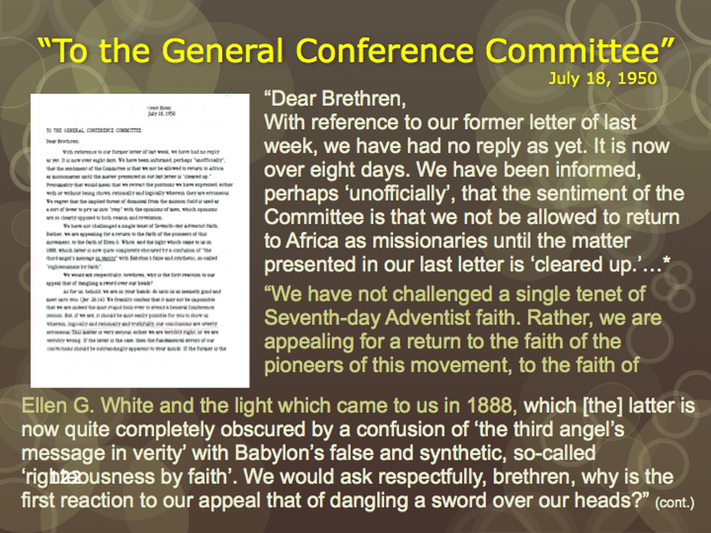
1 of 4 Slides.
*It would appear that some kind of “unofficial” response was reported to them of the reaction of the General Conference Committee, and that the sentiment was not to allow them to return to Africa until the matter was cleared up.
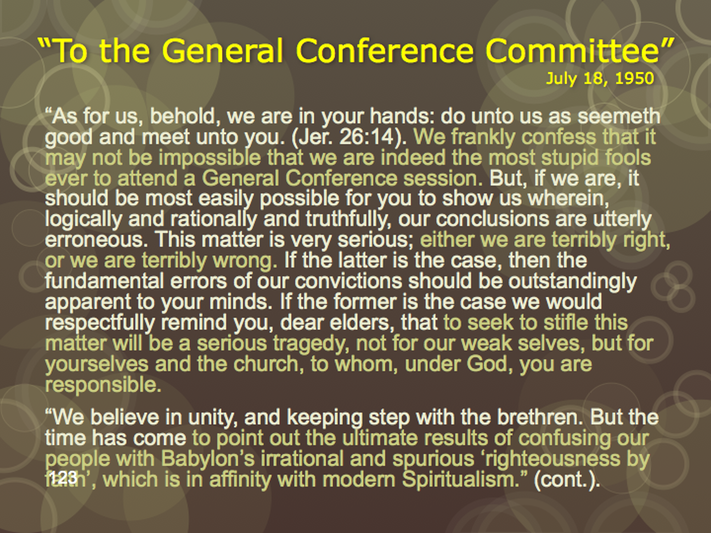
2 of 4 Slides.
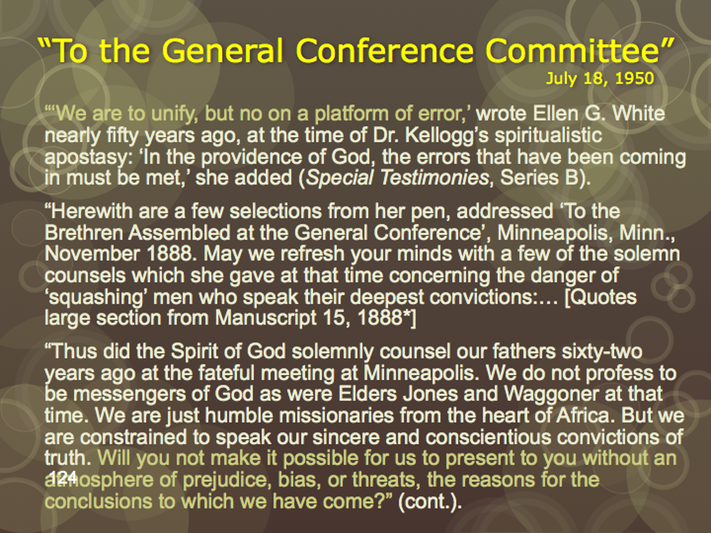
3 of 4 Slides.
*See 1888 Materials, pp. . In this manuscript Ellen White warns not to rise up against message sent from God through Jones and Waggoner
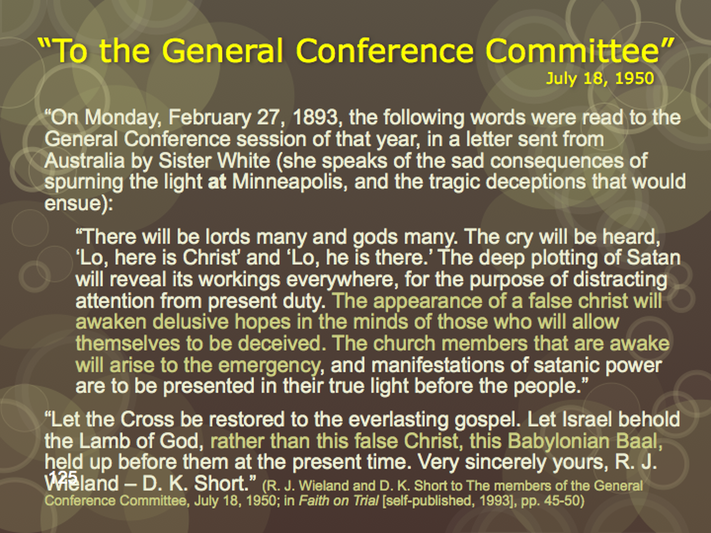
4 of 4 Slides.
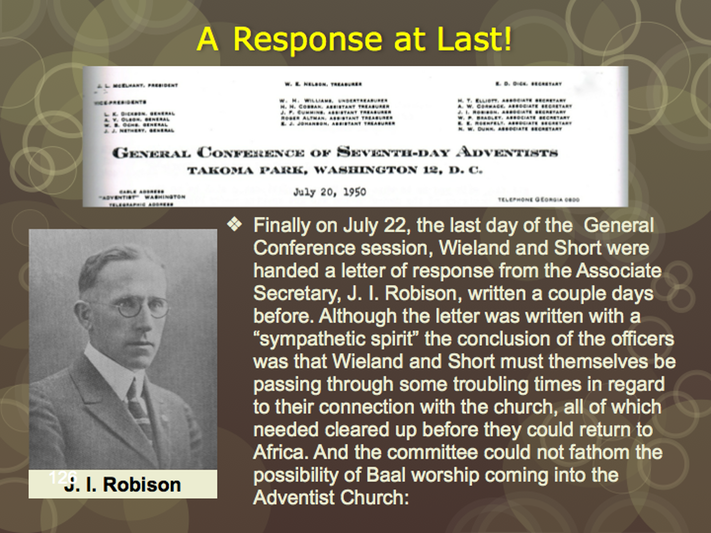
http://http://documents.adventistarchives.org/Periodicals/GCSessionBulletins/GCB1958-08.pdf, p. 192
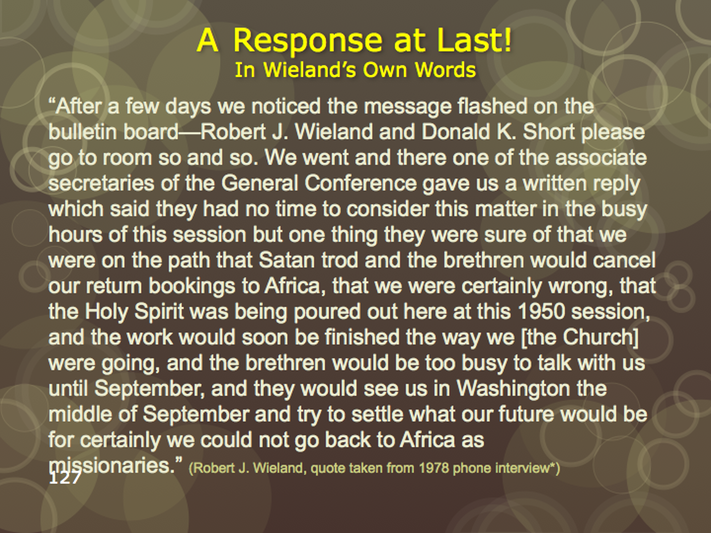
*(Robert J. Wieland, in Bradley Roy Williams, “Robert J. Wieland Before 1888 Re-examined, and Some of His Effect on Adventists,” A Report Presented in Partial Fulfillment of the Requirements for the Course CHIS 574, Development of Seventh-day Adventist Theology, Andrews University, Autumn 1978, Appendix K, “Wieland, Pre-1950,” p. 6; http://www.andrews.edu/library/car/cardigital/digitized/documents/b10122114.pdf, accessed Oct. 2014)
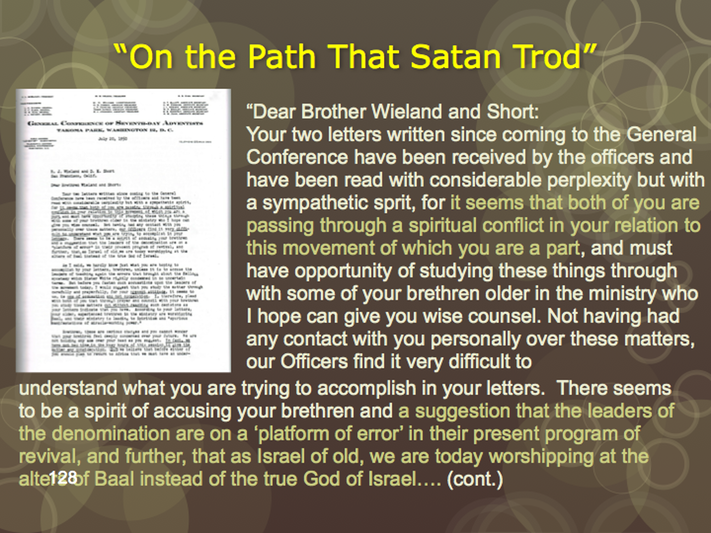
1 of 2 Slides.
(J. I. Robison to R. J. Wieland and D. K. Short, July 20, 1950; in Faith on Trial, pp. 51-52)
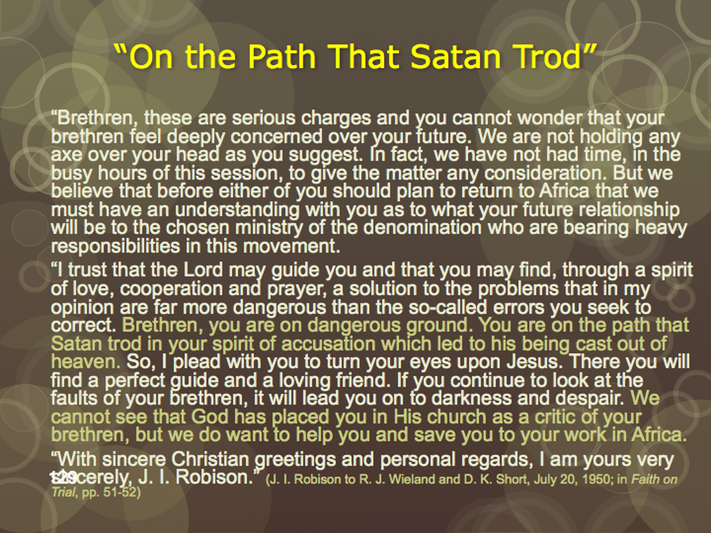
2 of 2 Slides.
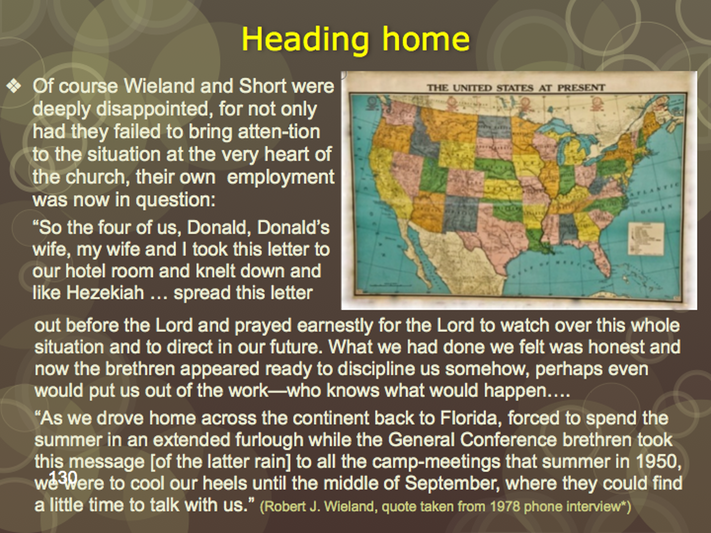
*(Robert J. Wieland, in Bradley Roy Williams, “Robert J. Wieland Before 1888 Re-examined, and Some of His Effect on Adventists,” A Report Presented in Partial Fulfillment of the Requirements for the Course CHIS 574, Development of Seventh-day Adventist Theology, Andrews University, Autumn 1978, Appendix K, “Wieland, Pre-1950,” pp. 21, 22; http://www.andrews.edu/library/car/cardigital/digitized/documents/b10122114.pdf, accessed Oct. 2014)
Photo credit: http://www.urbanremainschicago.com/media/catalog/product/cache/1/image/650x/040ec09b1e35df139433887a97daa66f/2/0/20110509-20110509-023n.jpg
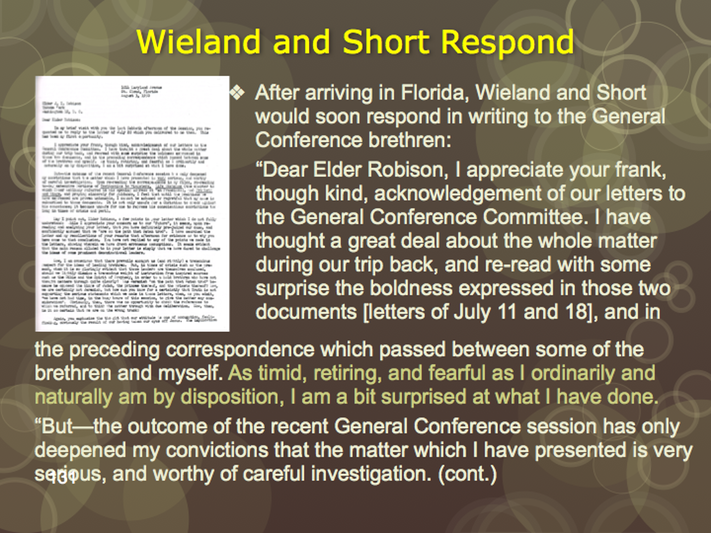
1 of 2 Slides.
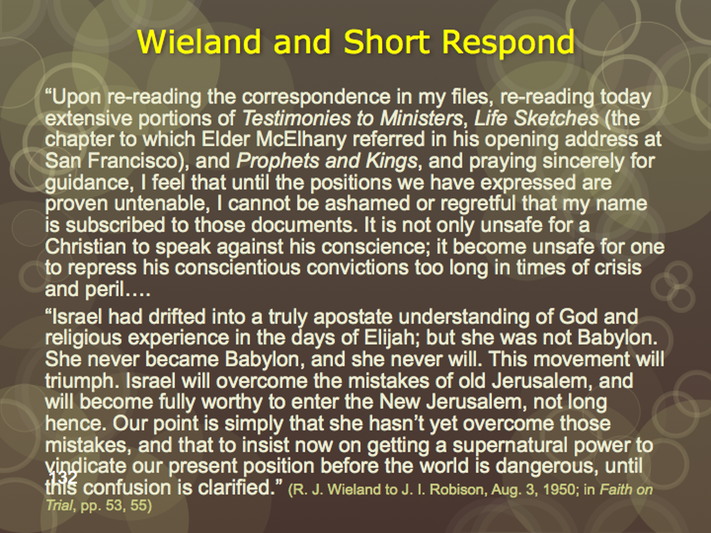
2 of 2 Slides.
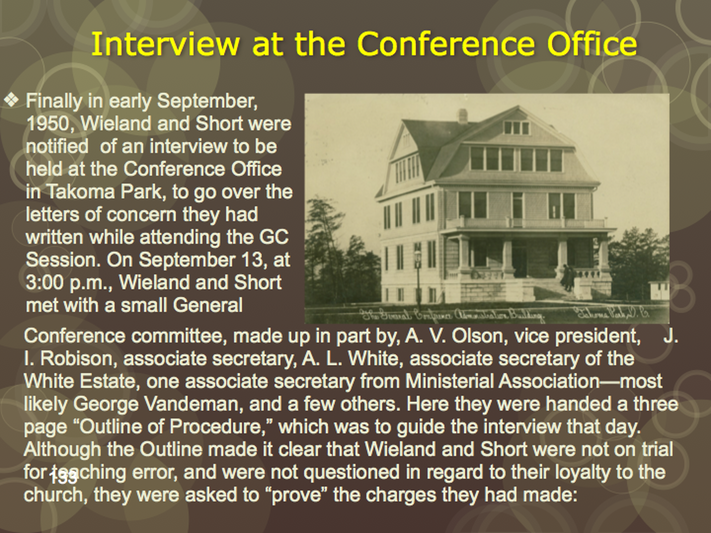
https://photo.egwwritings.org/index.php?album=Institutions&image=612.8.1.jpg
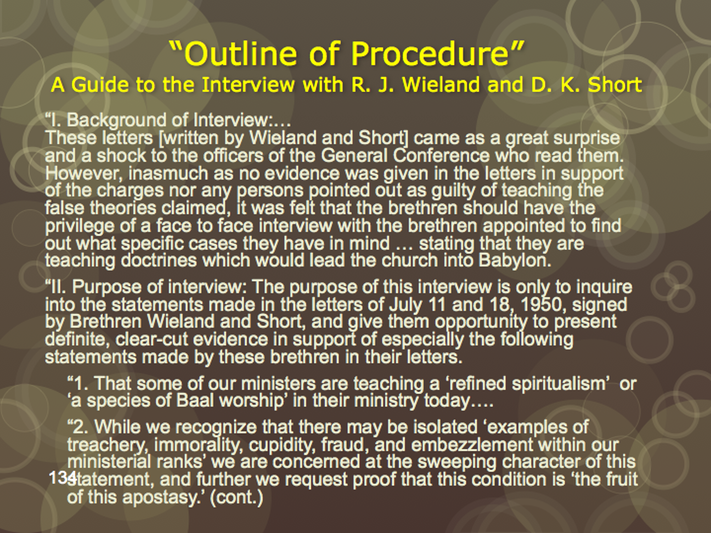
1 of 2 Slides.
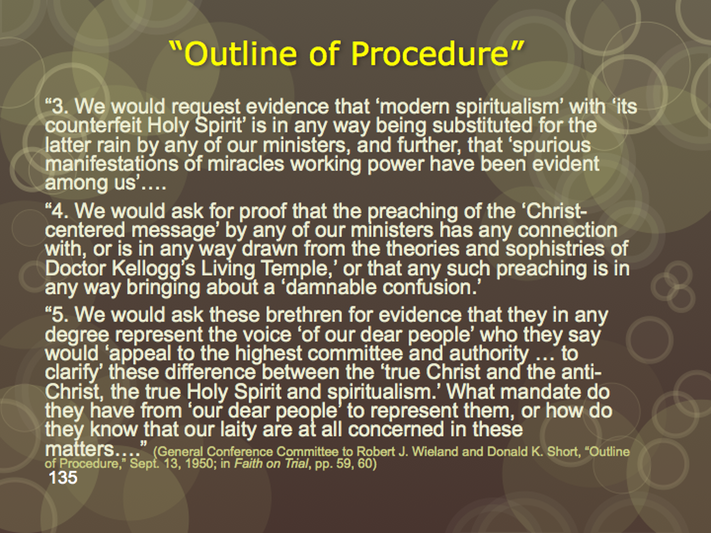
2 of 2 Slides.
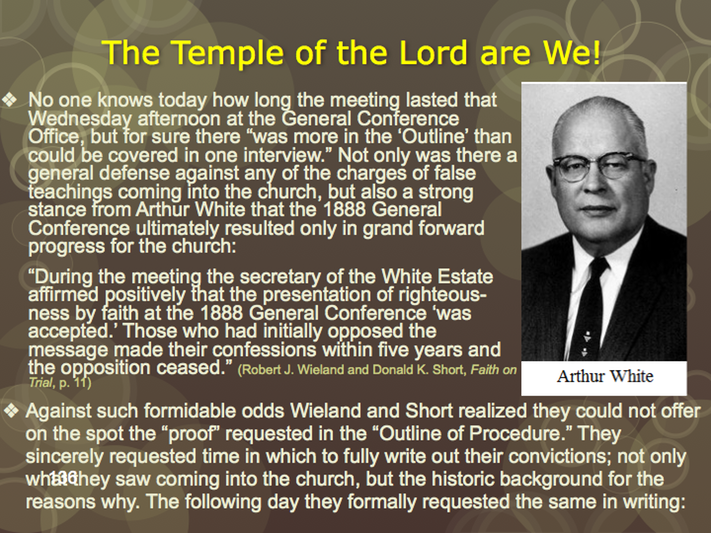
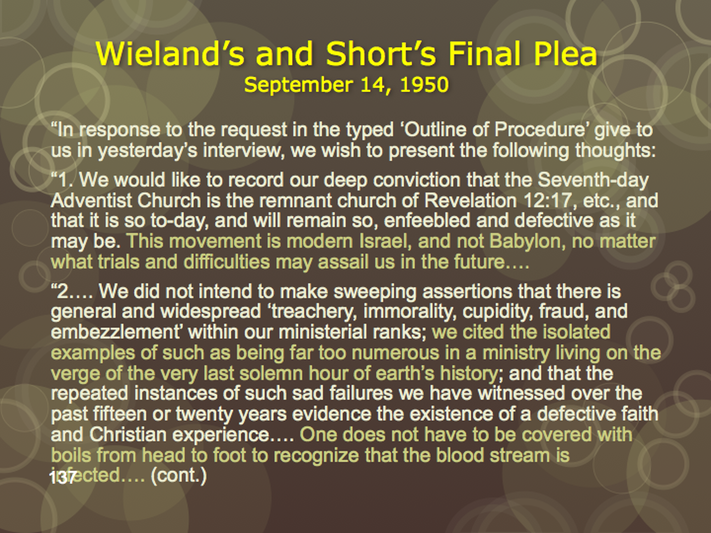
1 of 3 Slides.
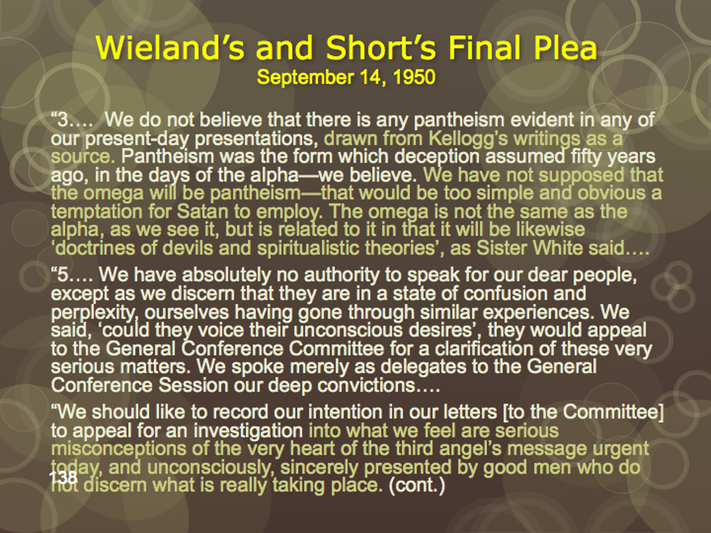
2 of 3 Slides.
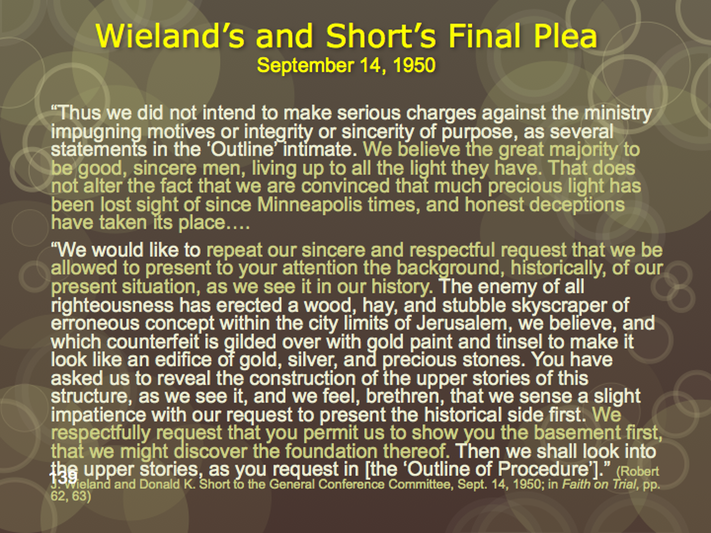
3 of 3 Slides.
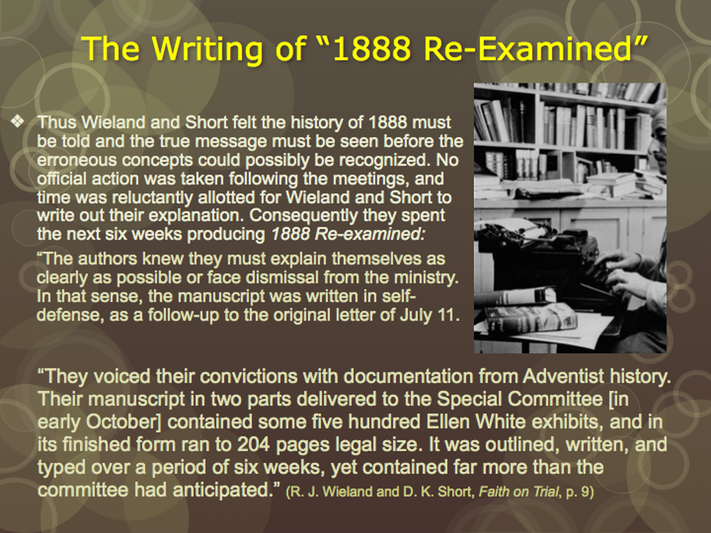
Read "1888 Re-examined" here
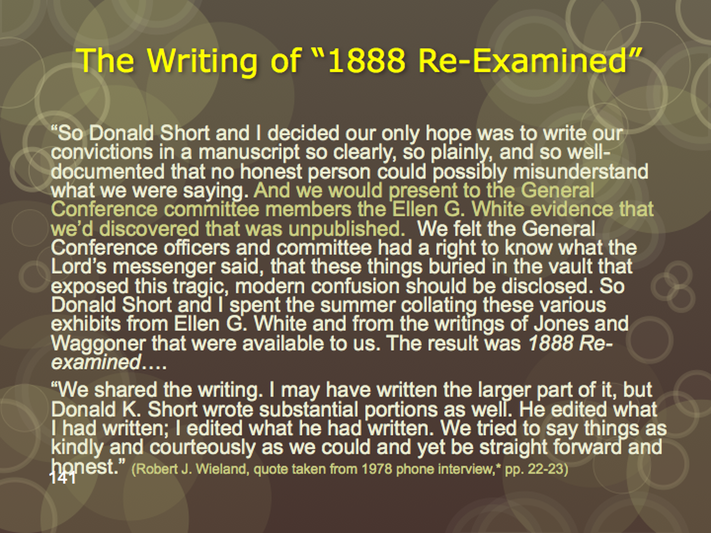
*(Robert J. Wieland, in Bradley Roy Williams, “Robert J. Wieland Before 1888 Re-examined, and Some of His Effect on Adventists,” A Report Presented in Partial Fulfillment of the Requirements for the Course CHIS 574, Development of Seventh-day Adventist Theology, Andrews University, Autumn 1978, Appendix K, “Wieland, Pre-1950,” pp. 22-23; http://www.andrews.edu/library/car/cardigital/digitized/documents/b10122114.pdf, accessed Oct. 2014)
Read "1888 Re-examined" here
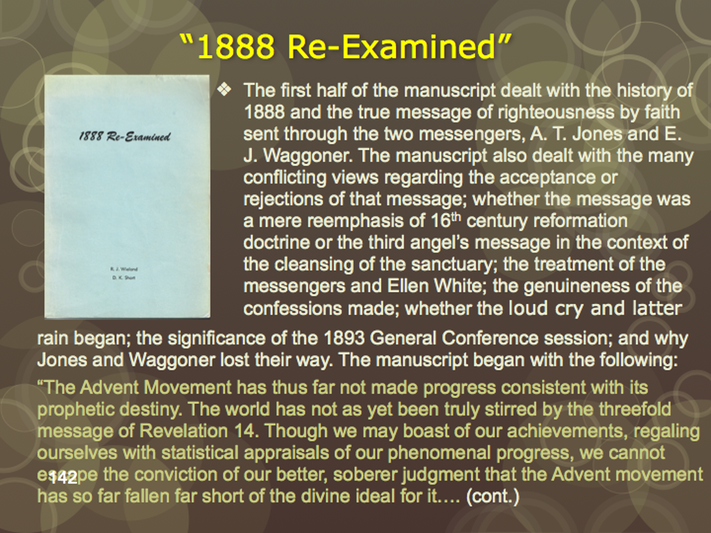
1 of 2 Slides.
The original 15 copies of the manuscript submitted to the General Conference Committee, did not have a title page, a date or the authors names.
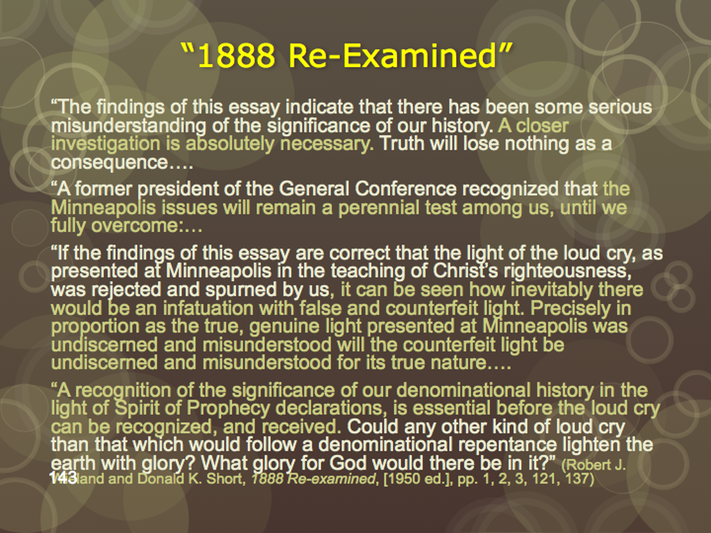
2 of 2 Slides.
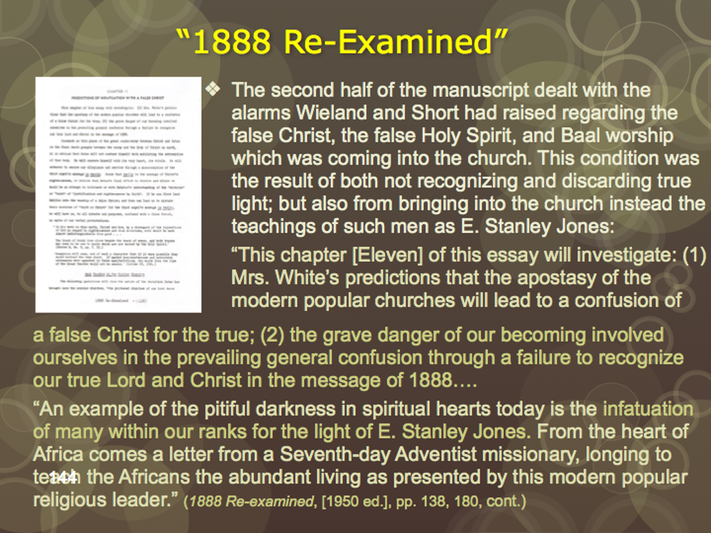
1 of 6 Slides.
Read "1888 Re-examined" here
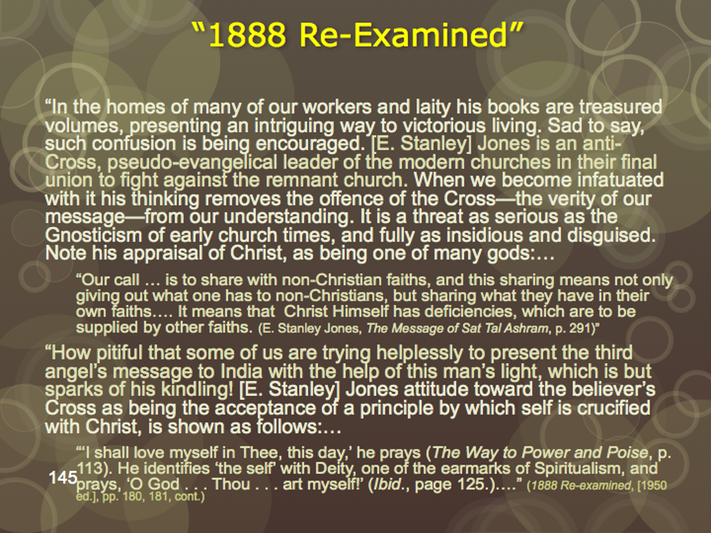
2 of 6 Slides.
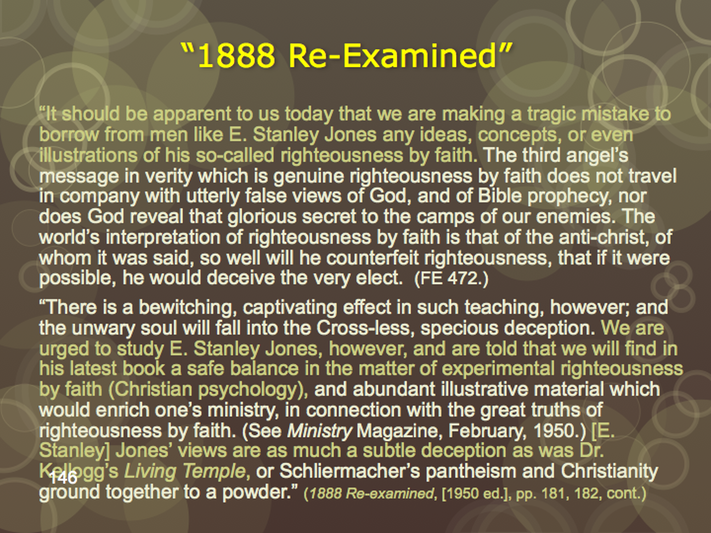
3 of 6 Slides.
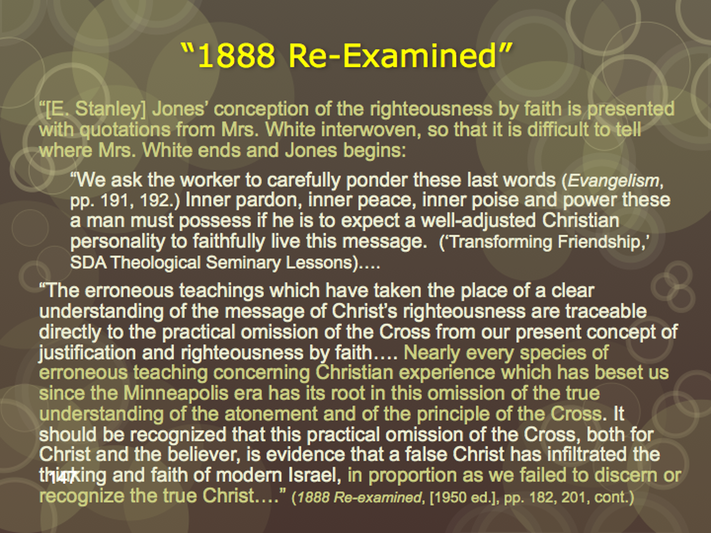
4 of 6 Slides.
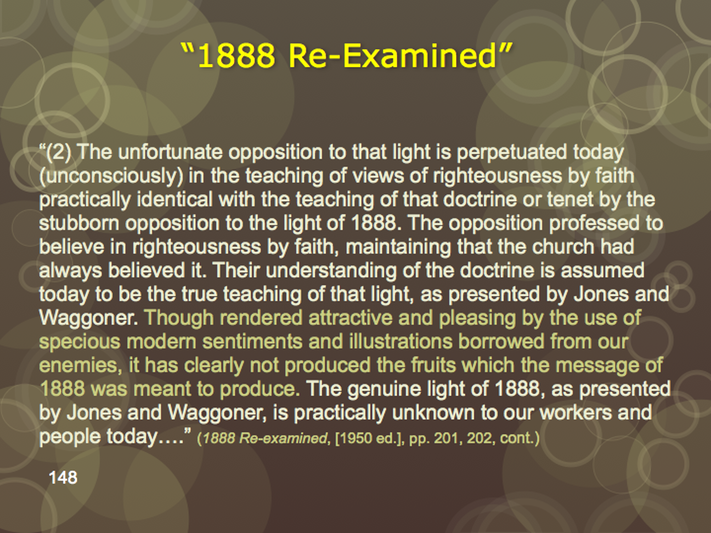
5 of 6 Slides.
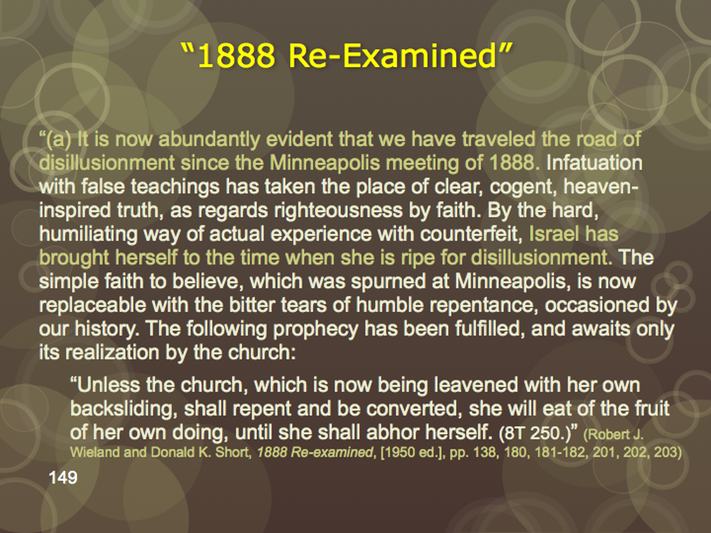
6 of 6 Slides.
Read "1888 Re-examined" here
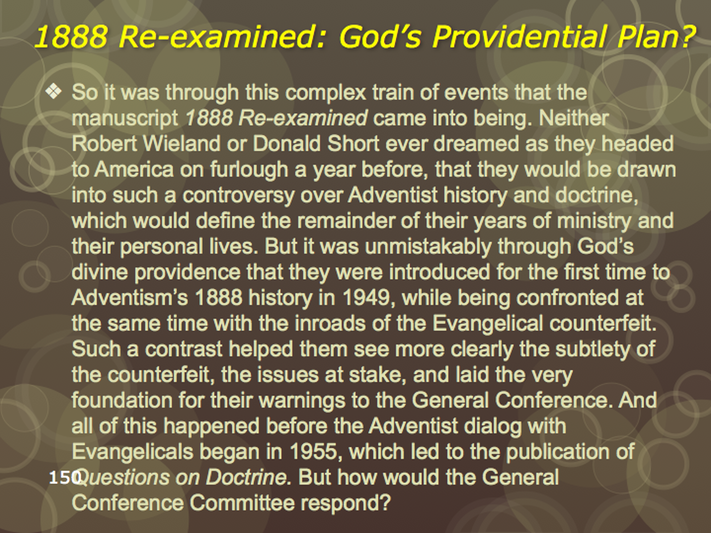
Read "1888 Re-examined" here
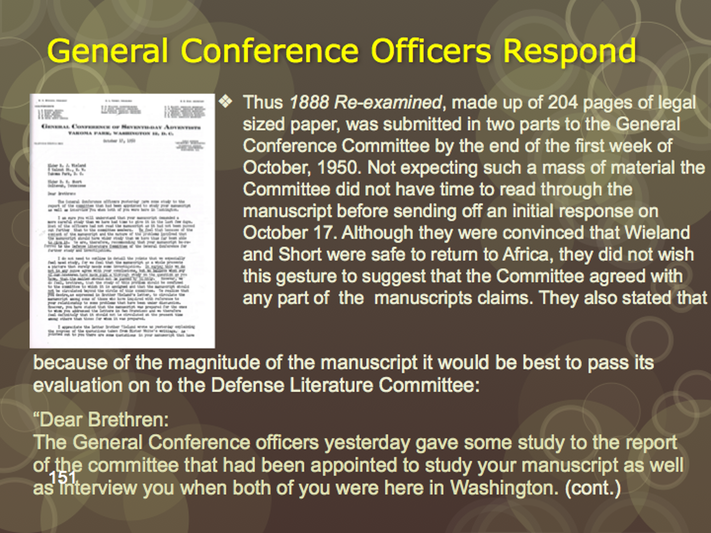
1 of 2 Slides.
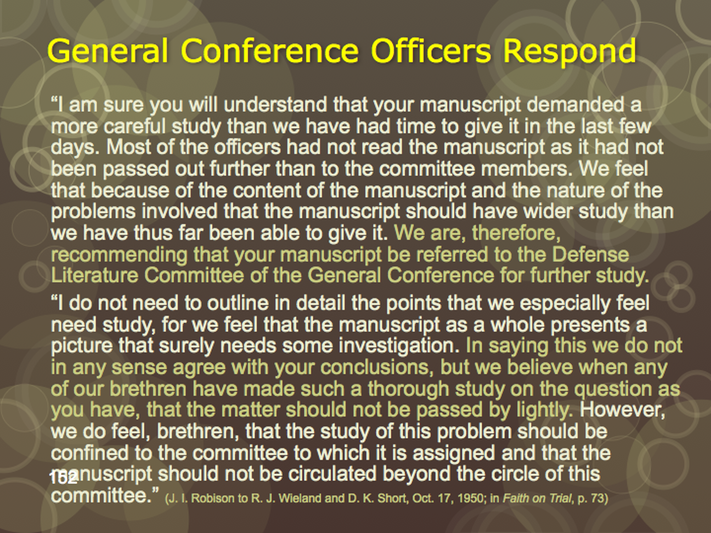
2 of 2 Slides.
Read "1888 Re-examined" here
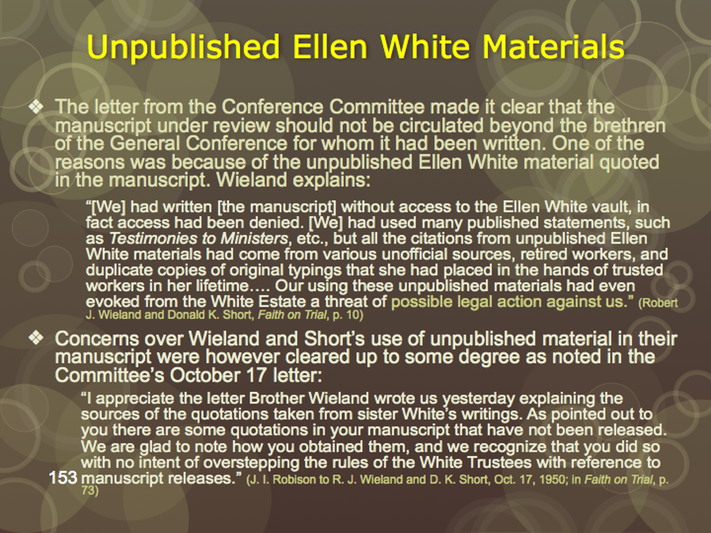
A lawsuit was at first threatened by some in the church against Wieland and Short for quoting from so many unpublished Ellen White letters and manuscripts and for their collecting of this material. This was later dropped, but, as Wieland states, shows the length to which some were willing to go to keep 1888 out of the public eye.
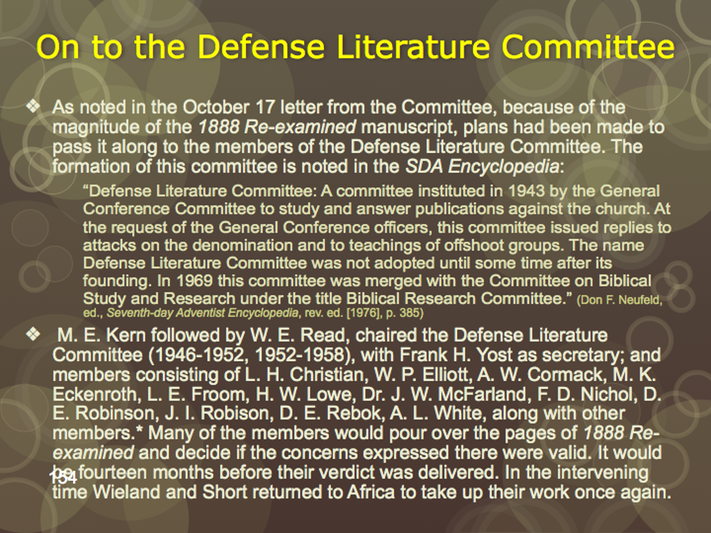
*(“Committee on Defense Literature,” General Conference Committee Minutes, May 10, 1948, pp. 1044-1045; located at http://docs.adventistarchives.org/docs/GCC/GCC1948-05.pdf#view=fit, accessed April 7, 2015)
(“Committee on Defense Literature,” General Conference Committee Minutes, November 11, 1948, p. 1270; located at, http://docs.adventistarchives.org/docs/GCC/GCC1948-11.pdf#view=fit, accessed April 7, 2015)

Read "1888 Re-examined" here
* (Review and Herald, July 16, 1950, p. 81; 1952 Yearbook, pp. 15-16; “Committee on Defense Literature,” General Conference Committee Minutes, May 10, 1948, pp. 1044-1045, and November 11, 1948, p. 1270; Robert J. Wieland and Donald K. Short, Faith on Trial, pp. 51, 58, 67,73, 80, 105, 108, 110, 111). Many of the same members were also on the Board of the White Estate: (A. L. White, “The Ellen G. White Publications,” Review and Herald, June 4, 1954, p. 246).
** (T. E. Unruh, “The Seventh-day Adventist Evangelical Conferences of 1955-1956,” Adventist Heritage, vol. 4, no. 2, p.)
R. A. Anderson: General Conference Field Secretary (1950-1958, at least) Ministry Magazine editor (1950-1966), on the Questions on Doctrine Committee.
W. R. Beach: Secretary of General Conference (1954- ), on the Questions on Doctrine Committee.
L. H. Christian: Author of the book The Fruitage of Spiritual Gifts (1947), on Defense Literature Committee.
L. K. Dickson: General Conference vice-president (1945-1958), special contributor to Review and Herald, on the Questions on Doctrine Committee.
L. E. Froom: General Conference Field Secretary (1954-1958, at least), author, editor, teacher and founder of Ministry magazine, on Defense Literature Committee, on the Questions on Doctrine Committee.
R. R. Figuhr (chairman): General Conference general vice-president (1950-1954), General Conference President (1954-1966), special contributor to Review and Herald, on the Questions on Doctrine Committee.
A. L. Ham: General Conference vice-president (1954 -1958, at least), on the Questions on Doctrine Committee.
H. W. Lowe: Chairman of the Bible Study and Research Group of the General Conference, on Defense Literature Committee.
F. D. Nichol: Review and Herald editor in chief (1945-1966), member of the Board of Trustees of the Ellen G. White Estate (1951-1966), editor of Seventh-day Adventist Bible Commentary, on Defense Literature Committee, on the Questions on Doctrine Committee.
W. B. Ochs: Vice-president of the General Conference for North America (1954-1962, at least), special contributor to Review and Herald, on the Questions on Doctrine Committee.
A. V. Olson: General Vice-president of the General Conference (1946-1958), Board chair of E. G. White Estate (1952-1963), special contributor to Review and Herald, on the Questions on Doctrine Committee.
W. E. Read: Field Secretary of the General Conference (1950-1962, at least), on Defense Literature Committee, on the Questions on Doctrine Committee.
D. E. Rebok: Theological Seminary President (1943-1951), Chair of White Estate Board, on Defense Literature Committee.
D. E. Robinson: Staff secretary Ellen G. White Estate (1928-1953).
J. I. Robison: Associate Secretary of the General Conference. (1950-1958, at least), Board of Trustees E. G. White Estate, on Defense Literature Committee, on the Questions on Doctrine Committee.
H. L. Rudy: General Conference vice-president (1950-1958, at least) special contributor to Review and Herald, on the Questions on Doctrine Committee.
C. L. Torrey: General Conference Treasurer (1950-1962 at least), special contributor to Review and Herald, on the Questions on Doctrine Committee.
T. E. Unruh: President of the East Pennsylvania Conference, on the Questions on Doctrine Committee.
A. L. White: Secretary (Director), Ellen G. White Estate board of trustees (1937-1978), on Defense Literature Committee.
Frank H. Yost: Chairman of the department of theology, SDA Theological Seminary (1950-1954), Editor Liberty, (1955-1958), associate secretary of GC Religious Liberty Dept. (1946-1950, 1954-1958), Board of Trustees E. G. White Estate, on Defense Literature Committee.
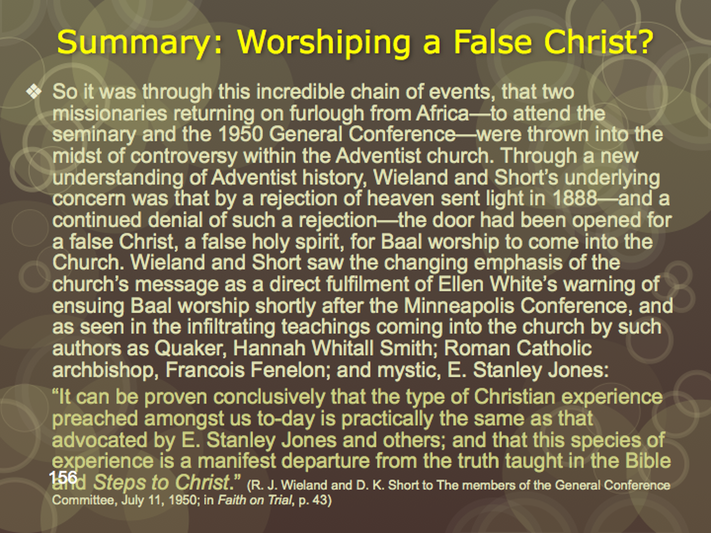
Call light darkness, will soon call darkness light.
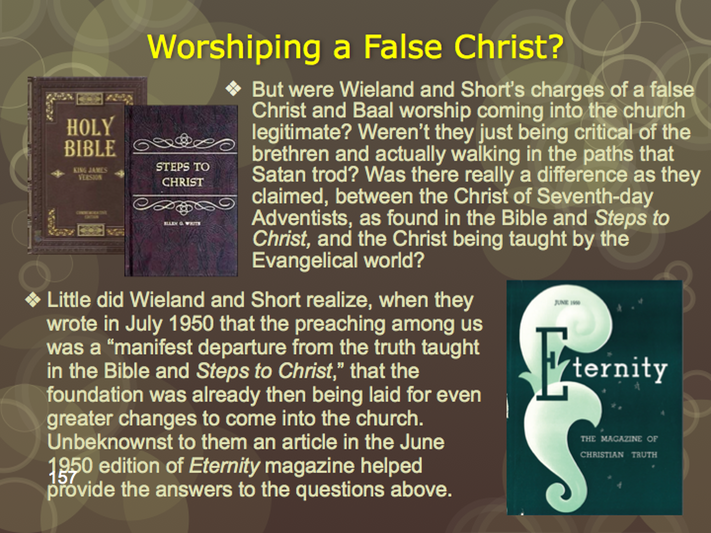
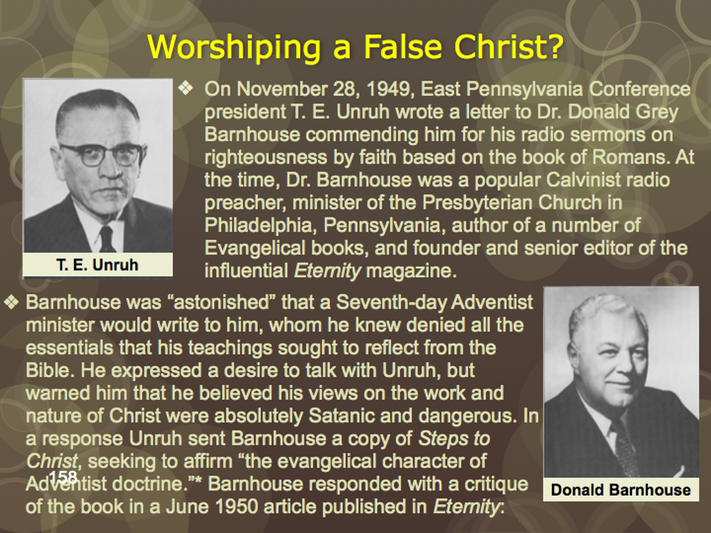
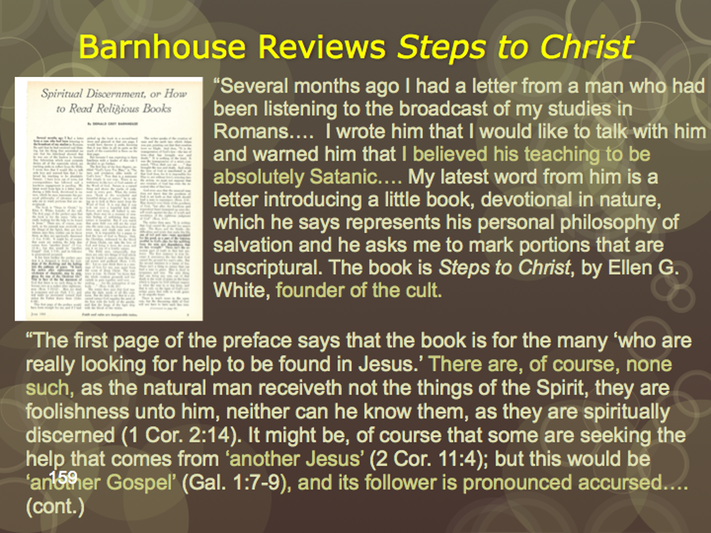
1 of 5 Slides
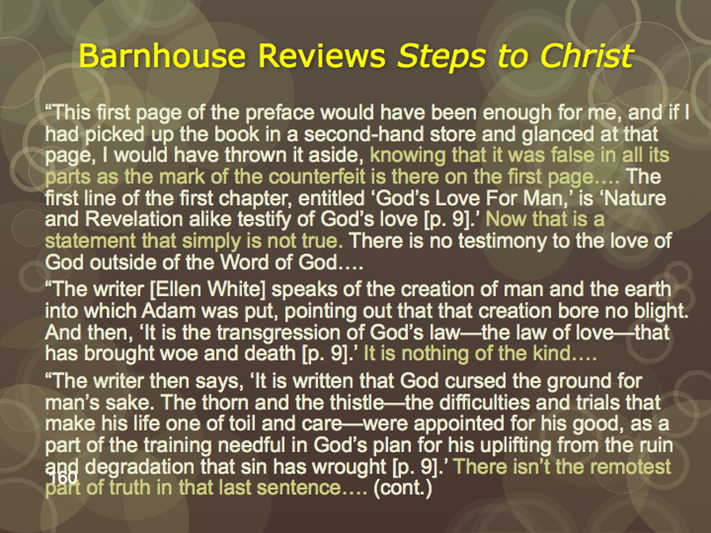
2 of 5 Slides.
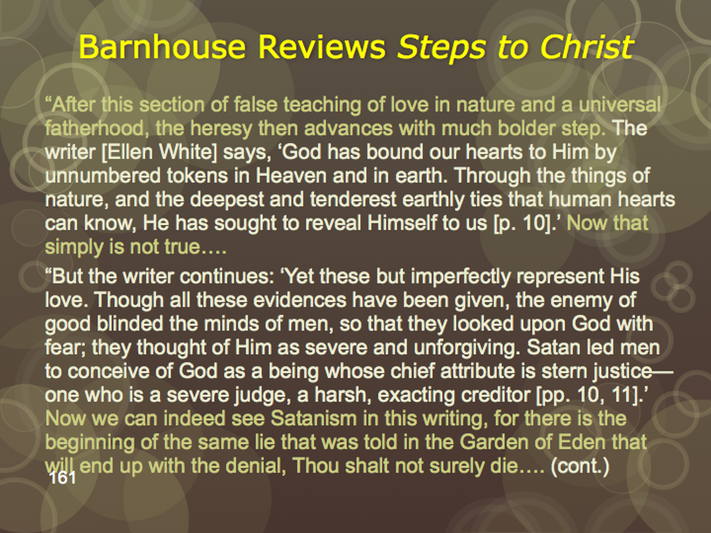
3 of 5 Slides.
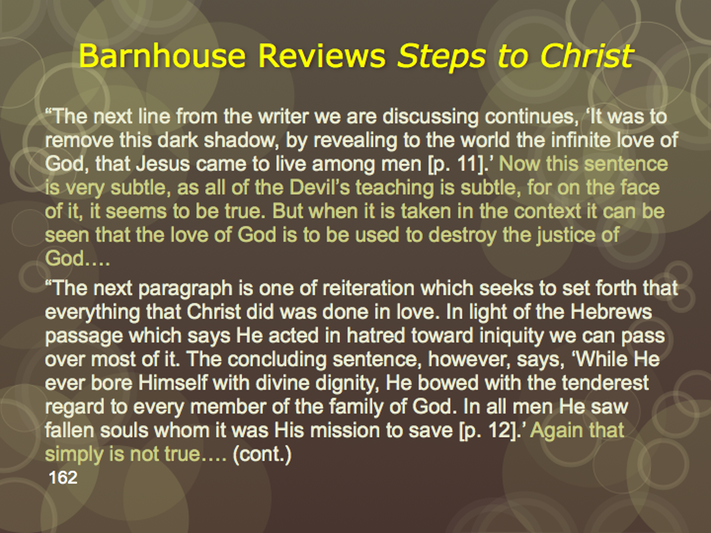
4 of 5 Slides.
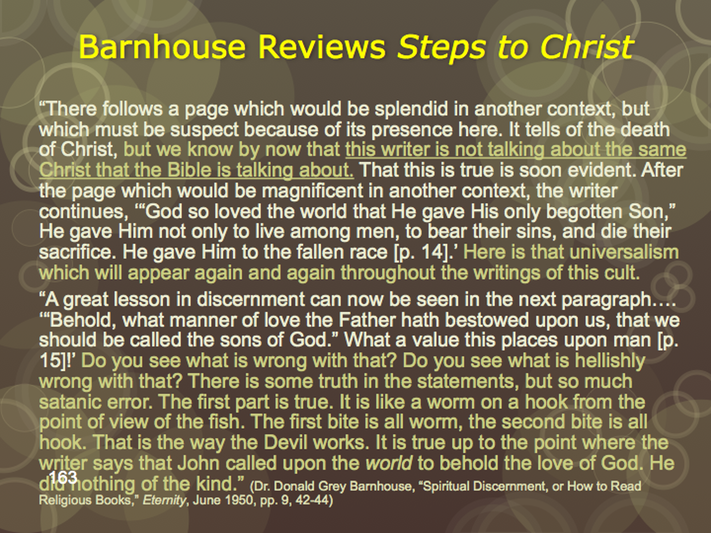
5 of 5 Slides.
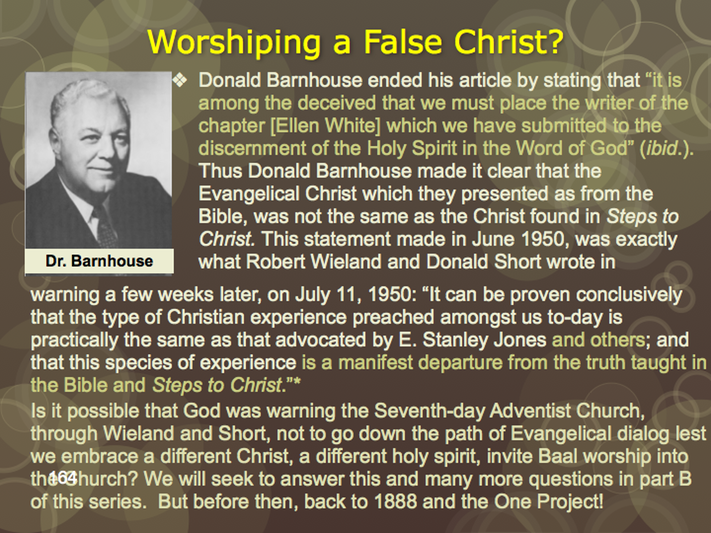
*(R. J. Wieland and D. K. Short to The members of the General Conference Committee, July 11, 1950; in Faith on Trial, p. 43)
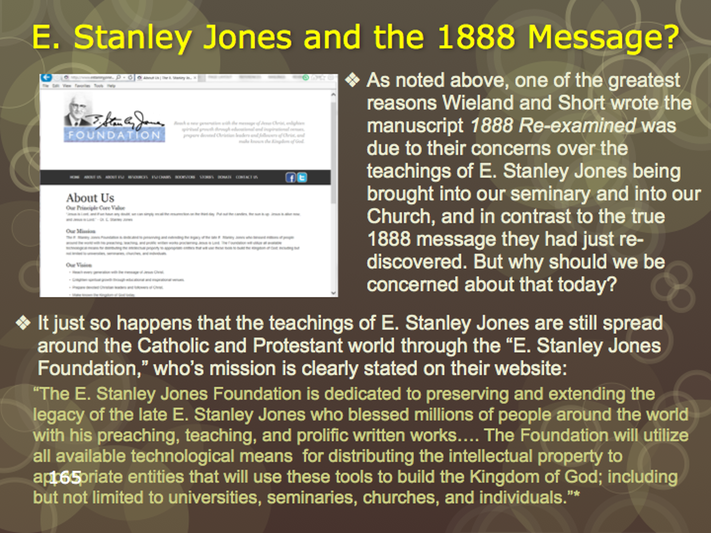
*(http://www.estanleyjonesfoundation.com/about-us/)
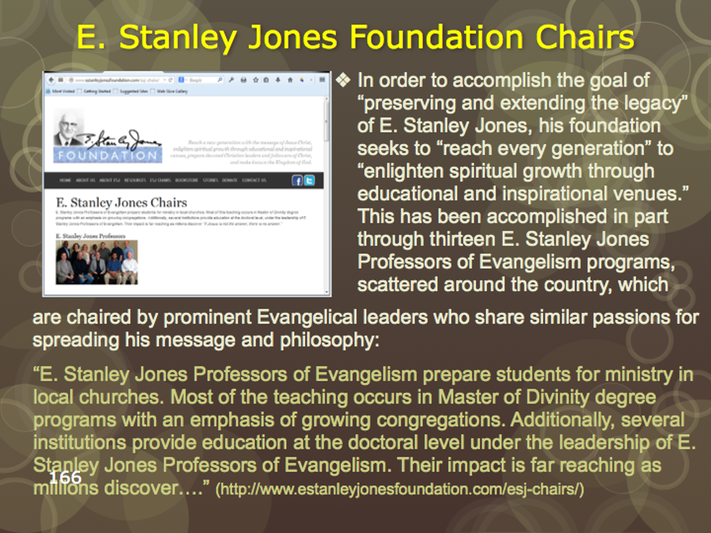
Places with E. Stanley Jones Chairs:
Duke Divinity School
Reutlingen School of Theology
Africa University
Russia United Methodist Theological Seminary
Methodist Theological School in Ohio
Wesley Theological Seminary
Boston University School of Theology
Drew University School of Theology
Garrett Evangelical Theological Seminary
Southern Methodist University School of Theology
Candler School of Theology
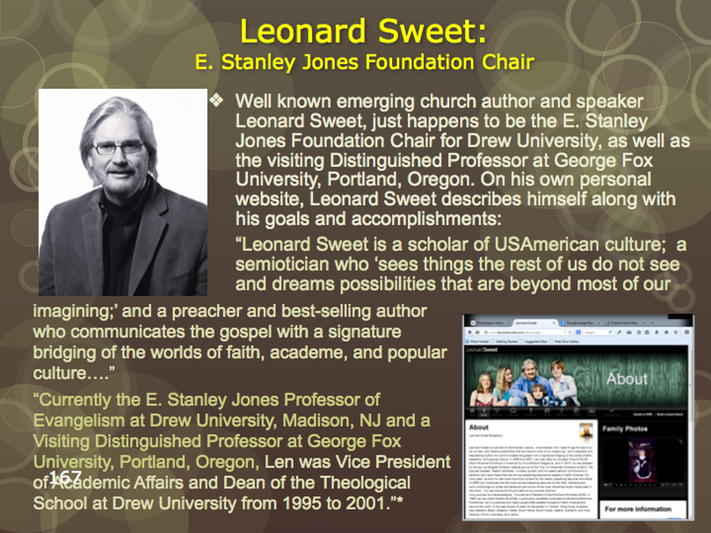
*(http://www.leonardsweet.com/about, accessed Oct. 2014)
Definition of SEMIOTICS: “a general philosophical theory of signs and symbols.” Leonard Sweet has been the primary person to make this word popular in the Emerging Church movement. He states that he bases it on Mat 16:3 “He answered and said unto them, When it is evening, ye say, It will be fair weather: for the sky is red. And in the morning, It will be foul weather to day: for the sky is red and lowring. O ye hypocrites, ye can discern the face of the sky; but can ye not discern the signs of the times?” The Greek word is “sēmeion” which means: “an indication, especially ceremonially or supernaturally: - miracle, sign, token, wonder.” Sweet seems to use it as a term that describes himself and his cohorts and followers, who can see the signs in different religions, cultures and histories.
For an evaluation of the Emerging Church and the work and involvement of Leonard Sweet, see; “The Emerging Church and The One Project?” presentations 1 through 4, at: http://thegreatcontroversy.info/power-point-presentations.html
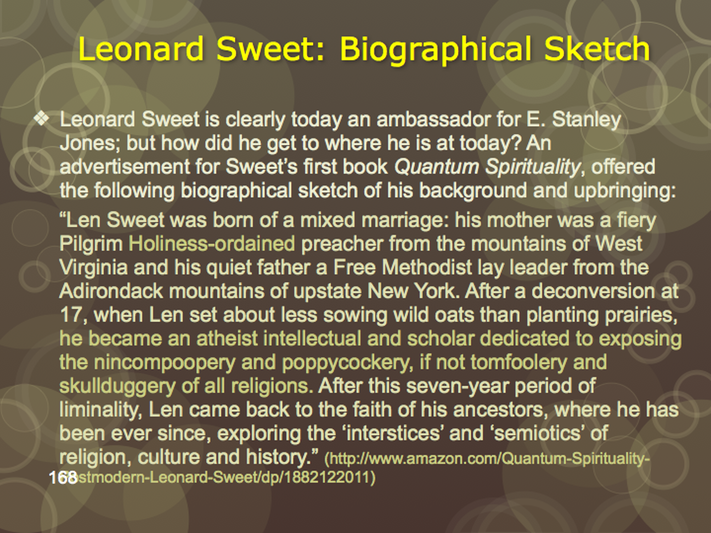
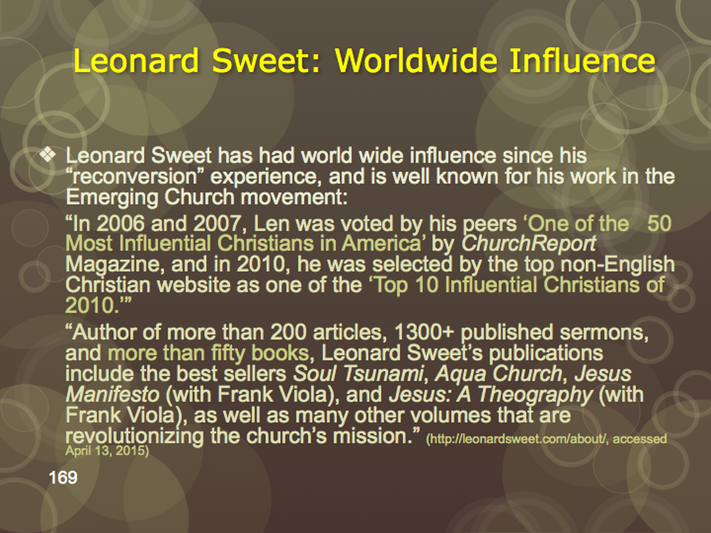
(http://leonardsweet.com/about/, accessed April 13, 2015)
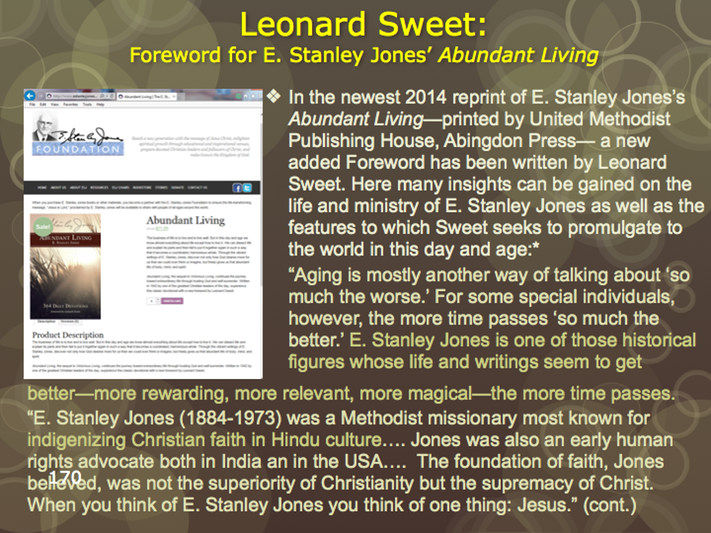
1 of 4 Slides.
*http://www.estanleyjonesfoundation.com/shop/abundant-living/ The entire Foreword can be read at: http://www.amazon.com/Abundant-Living-364-Daily-Devotions/dp/1426796226#reader_B00MR5V0QO
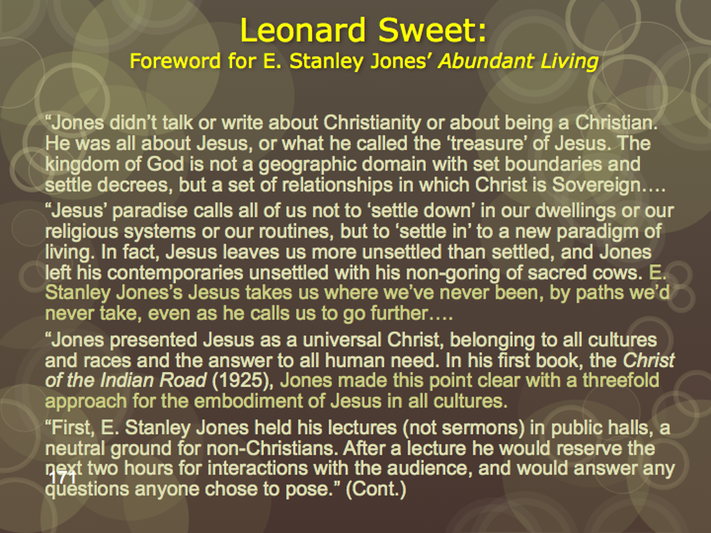
2 of 4 Slides.
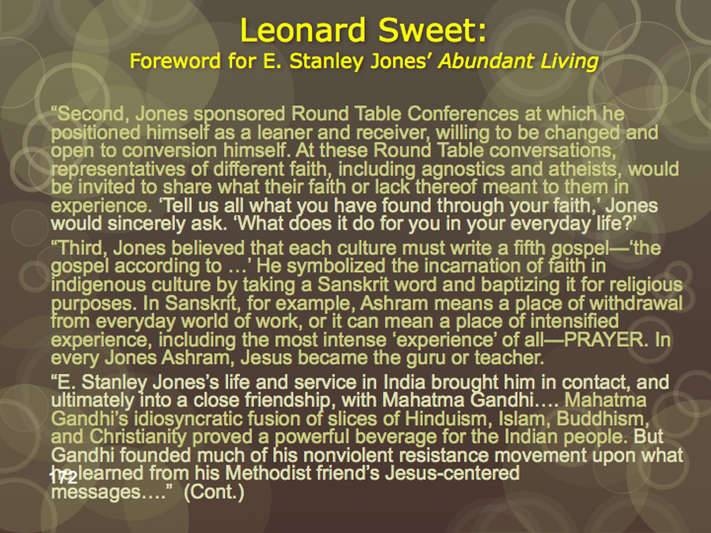
3 of 4 Slides.
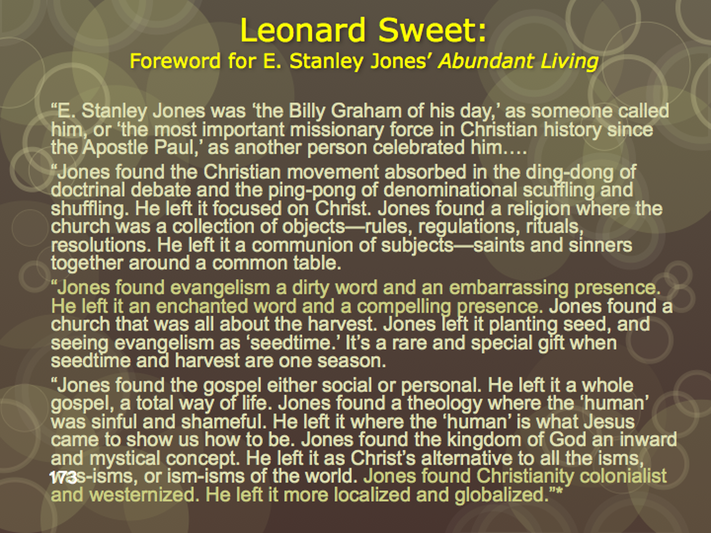
4 of 4 Slides.
*(Leonard Sweet, “So Much the Better,” Foreword, in E. Stanley Jones, Abundant Living: 364 Daily Devotions [Nashville, TN: Abingdon Press, 2014 ed.], p. ; at http://www.amazon.com/Abundant-Living-364-Daily-Devotions/dp/1426796226#reader_B00MR5V0QO, accessed April 25, 2015)
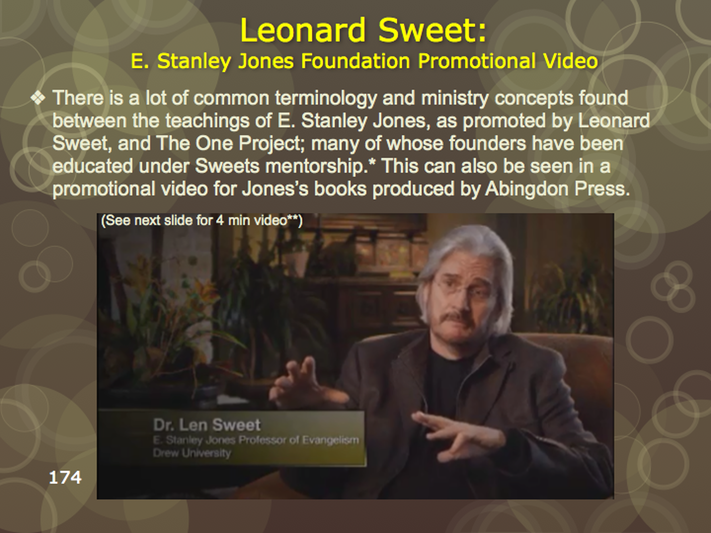
*See slides 183 to 186.
**https://www.youtube.com/watch?v=WMA2BLjW9ZU
Leonard Sweet
E. Stanley Jones Foundation Promotion Video
*https://www.youtube.com/watch?v=WMA2BLjW9ZU
For a longer version of this interview, which expresses more of the E. Stanley Jones Foundation’s attempt to reach the youth, see: https://www.youtube.com/watch?v=FjeV2EUG8_g. Although much of the concepts sound so good, and has elements of truth, E. Stanley Jones's mystical concepts will inevitably open the door for spiritualism, ecumenism, and kingdom here and now theology which will be the mantra of a final one world religion.
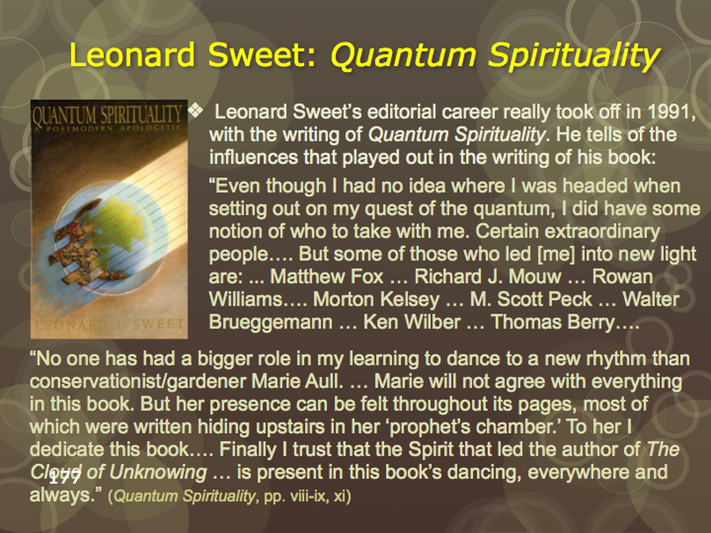
Published in 1991. “This was Len’s ‘coming out’ book as a postmodern disciple after his 1987 knockdown, drag-out Damascus Road encounter with God, who (as he describes it) ‘knocked me off my high academic horse and said, ‘Sweet, are you going to get a mission for the world you wish you had or the world that's actually out there.’”
http://disciple21century.com/ECreferencelibrary-Sweeet.htm
From the “Acknowledgement” Section of the book Sweet thanks many leading New Agers.
Matthew Fox: is an American priest and theologian.[1] Formerly a member of the Dominican Order within the Roman Catholic Church, he is now a member of the Episcopal Church. Fox was an early and influential exponent of a movement that came to be known as Creation Spirituality. The movement draws inspiration from the mystical philosophies of such medieval Catholic visionaries as Hildegard of Bingen, Thomas Aquinas, Saint Francis of Assisi, Julian of Norwich, Dante Alighieri, Meister Eckhart and Nicholas of Cusa, as well as the wisdom traditions of Christian scriptures. Creation Spirituality is also strongly aligned with ecological and environmental movements of the late 20th century and embraces numerous spiritual traditions around the world, including Buddhism, Judaism, Sufism, and Native American spirituality, with a focus on "deep ecumenism". … Fox’s book The Coming of the Cosmic Christ: The Healing of Mother Earth and the Birth of a Global Renaissance delves more into these issues.
More Books by Fox: One River, Many Wells: Wisdom Springing from Global Faith; His book on the mysticism of Thomas Aquinas translates many of his works that have never before been translated into English.
Worship: Fox's "Techno Cosmic Masses" (more recently just called "Cosmic Masses") are events that attempt to combine the religious ritual of the Eucharist with dance and multimedia material, deejays, video jockeys and rap music. They evoke and connect spiritual rituals and the ecstatic energy of Techno music and rave parties. They developed from a group called the Nine O'Clock Service in Sheffield, England in the late 1980s and early 1990s and was brought to the United States and further developed by Fox in the mid 1990s.
95 Thesis: In 2005, while preparing for a presentation in Germany and following the naming of Cardinal Ratzinger as Pope Benedict XVI, Fox created 95 theses that he then translated into German. On the weekend of Pentecost, arrangements were made for him to nail these to the door of the Wittenberg church where Martin Luther nailed the original 95 Theses in the 16th century, the act credited as the beginning of the Protestant Reformation.[1][16] The action fueled the creation of a lively blog involving tens of thousands of Germans. In his theses, Fox called for a new reformation in Western Christianity. In his supporting book, A New Reformation, Fox argued that two Christianities already exist and it is time for a new reformation to acknowledge that fact and move the Western spiritual tradition into new directions. Fox is also supportive of homosexuality.
Richard J. Mouw: is an American theologian and philosopher. He is currently President at Fuller Theological Seminary, where he also holds the post of Professor of Christian Philosophy. Dialogue with Catholics: In 2009, he signed a public statement encouraging all Christians to "read, wrestle with, and respond to Caritas in Veritate", the social encyclical by Pope Benedict XVI.
Rowan Williams: Rowan Williams is an Anglican bishop, poet and theologian. He was the 104th and current Archbishop of Canterbury. He is anti-creationist, pro-evolutionist, pro-homosexuality. He has written on Saint Teresa of Avila, a Spanish Roman Catholic mystic. He is active in the ecumenical movement and seeking reunion of the Church of England and Rome.
Pantheism runs through all of these authors. Look up the word with any of these names.
Morton Kelsey: author of over 30 books, and Episcopal priest, pro-homosexuality, charismatic Christian, is into new forms of worship and meditation: Dreams: A Way to Listen to God; Healing and Christianity; The Other Side of Silence: Meditation for the Twenty-first Century; Companions On The Inner Way: The Art of Spiritual Guidance; Adventure Inward; Transcend: A Guide to the Spiritual Quest; Dreamquest: Native American Myth and the Recovery of Soul. Draws on the works of Ignatius Loyola and contemplative prayer practices.
M. Scott Peck: Christian/New Age thought. Wrote the book The Road Less Traveled, sold 10 million copies. "All of us who postulate a loving God and really think about it eventually come to a single terrifying idea: God wants us to become Himself (or Herself or Itself). We are growing toward godhood. God is the goal of evolution." [page 270] “To put it plainly, our unconscious is God. God within us. We were part of God all the time. God has been with us all along, is now, and always will be.“ [p. 281]
Walter Brueggemann: is an American Protestant Old Testament scholar and theologian and an important figure in Progressive Christianity. Brueggemann is widely considered one of the most influential Old Testament scholars of the last several decades. Brueggemann is an advocate and practitioner of rhetorical criticism. He has written more than 58 books, hundreds of articles, and several commentaries on books of the Bible. Dr. Brueggemann is known throughout the world for his method of combining literary and sociological modes when reading Bible. An ordained minister in the United Church of Christ, Dr. Brueggemann currently resides in Cincinnati, Ohio (2008). United church of Christ is more liberal in views of ecumenism, equal rights, etc.
Ken Wilber: is an American author who has written about mysticism, philosophy, ecology, and developmental psychology. His work formulates what he calls Integral Theory. Very much into spiritualism/New Age thought, lived in Boulder CO while writing some of his books, he is into Buddhist meditation. Books include: The Spectrum of Consciousness; Sex, Ecology, Spirituality; Up from Eden: A Transpersonal View of Human Evolution; Spiritual Choices: The Problem of Recognizing Authentic Paths to Inner Transformation; Transformations of Consciousness: Conventional and Contemplative Perspectives on Development .
Thomas Berry: was a Catholic priest of the Passionist order, cultural historian and ecotheologian (although cosmologist and geologian — or “Earth scholar” — were his preferred descriptors). Among advocates of deep ecology and "ecospirituality" he is famous for proposing that a deep understanding of the history and functioning of the evolving universe is a necessary inspiration and guide for our own effective functioning as individuals and as a species. Books include: Buddhism (1968) The Religions of India (1972) The Dream of the Earth (1988) Befriending the Earth (with Thomas Clarke, 1991).
“The Cloud of Unknowing is an anonymous work of Christian mysticism written in Middle English in the latter half of the 14th century. The text is a spiritual guide on contemplative prayer in the late Middle Ages. The underlying message of this work proposes that the only way to truly ‘know’ God is to abandon all preconceived notions and beliefs or ‘knowledge’ about God and be courageous enough to surrender your mind and ego to the realm of ‘unknowingness,’ at which point, you begin to glimpse the true nature of God.”
“In a follow-up to The Cloud, called The Book of Privy Counseling, the author characterizes the practice of contemplative unknowing as worshiping God with one's ‘substance,’ coming to rest in a ‘naked blind feeling of being,’ and ultimately finding thereby that God is one's being.” (http://en.wikipedia.org/wiki/The_Cloud_of_Unknowing)
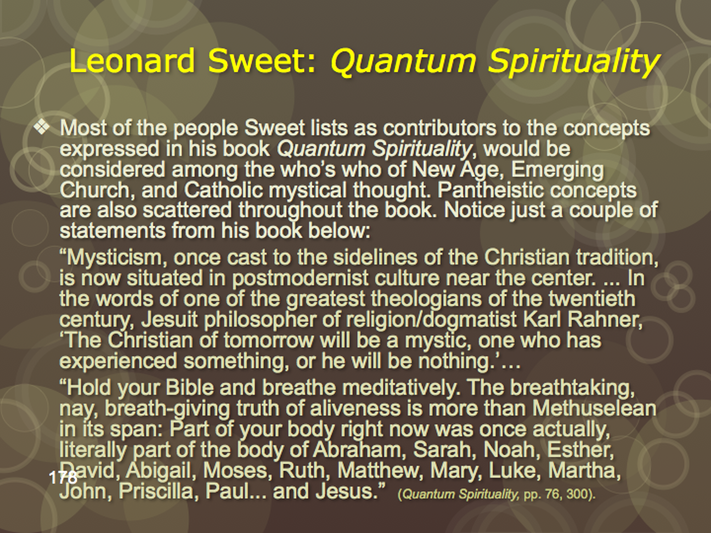
For a more in-depth look at the teachings of Leonard Sweet see the three part PowerPoint series, “The Emerging Church & The One Project? Leonard Sweet,” part 2 to 4; at http://thegreatcontroversy.info/power-point-presentations.html
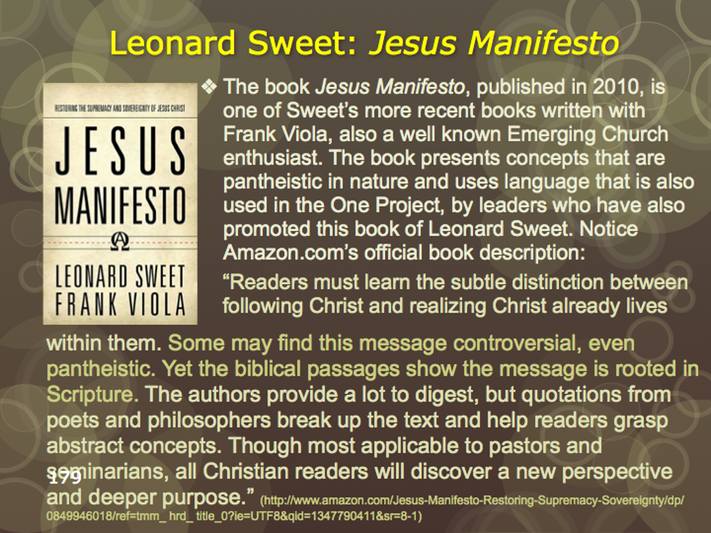
For more information on Sweet’s book Jesus Manifesto, see “The Emerging Church and The One Project?” presentation 3, at: http://thegreatcontroversy.info/power-point-presentations.html
Jesus Manifesto, June 2010.
“Frank Viola has been pioneering in organic missional church life since 1988. He brings over 20 years of experience to the table in what is now a growing phenomenon. Beyond planting organic missional churches, he is a bestselling author and sought-after conference speaker. Frank's public speaking covers a wide range of topics including the centrality, supremacy, and all-sufficiency of Jesus Christ, the deepening of the spiritual life, Christian community, church planting, God's eternal purpose, mission, and church renewal. He has written numerous books on the deeper Christian life and radical church reform, including the bestsellers From Eternity to Here, Jesus Manifesto (coauthored with Leonard Sweet), and Pagan Christianity? (co-authored with George Barna). …” (from his own website: http://frankviola.org/biography/)
He has written several other books: Reimagining Church: Pursuing the Dream of Organic Christianity; Finding Organic Church : A Comprehensive Guide to Starting and Sustaining Authentic Christian Communities; Beyond Evangelism; Epic Jesus: The Christ you Never Knew. Book sets sold under caption: “Its Time to ReChurch.” see also: (http://en.wikipedia.org/wiki/Simple_church)
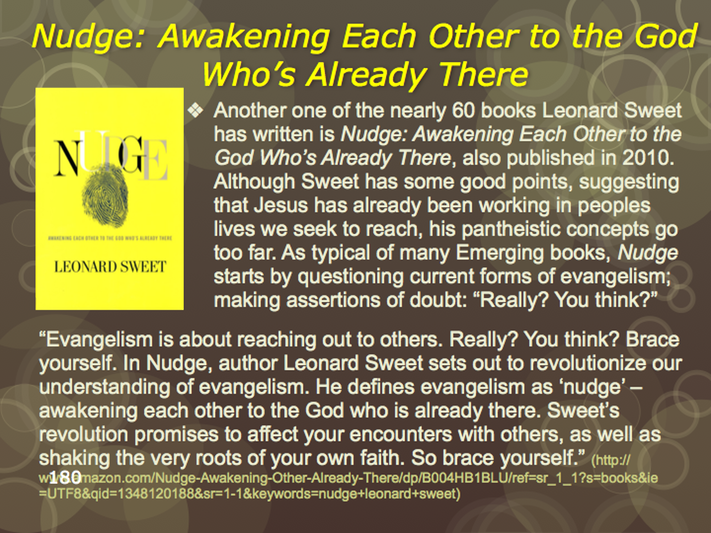
For more information on Sweet’s book Nudge, see “The Emerging Church and The One Project?” presentation 4, at: http://thegreatcontroversy.info/power-point-presentations.html
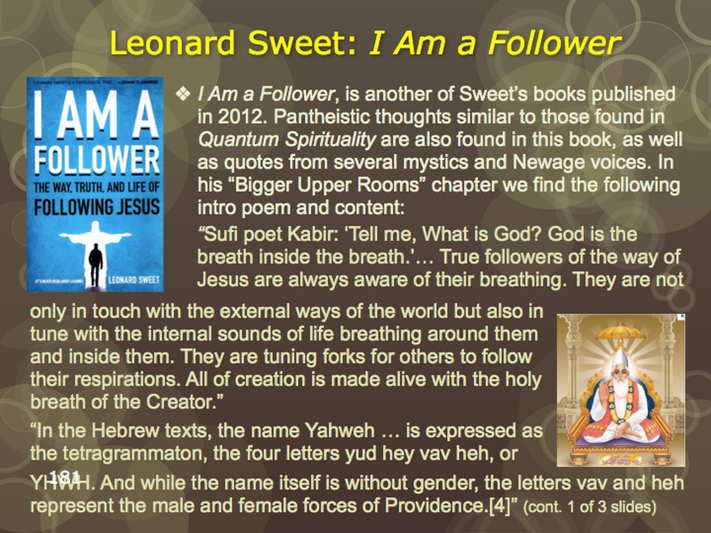
Notice: “Leonard Sweet is a theological poet.”—Shane Claiborne. (on cover) “Its never been about leading”. (on cover at bottom).
“Kabī (1440-1518) was a mystic poet and sant of India, whose writings have greatly influenced the Bhakti movement. The name Kabir comes from Arabic al-Kabīr which means 'The Great' – the 37th name of God in Islam. Apart from having an important influence on Sikhism, Kabir's legacy is today carried forward by the Kabir Panth (‘Path of Kabir’), a religious community that recognizes him as its founder and is one of the Sant Mat sects. Its members, known as Kabir panthis, are estimated to be around 9,600,000. Kabir was influenced by the prevailing religious mood of his times, such as old Brahmanic Hinduism, Tantrism, the teachings of Nath yogis and the personal devotionalism of South India mixed with the imageless God of Islam.[11] The influence of these various doctrines is clearly evident in Kabir's verses. Eminent historians … have held that Kabir is the first Indian saint to have harmonized Hinduism and Islam by preaching a universal path which both Hindus and Muslims could tread together.[12] … collection of poems elucidates Kabir's universal view of spirituality. Though his vocabulary is replete with Hindu spiritual concepts, such as Brahman, karma and reincarnation, he vehemently opposed dogmas, both in Hinduism and in Islam. … He often advocated leaving aside the Qur'an and Vedas and simply following Sahaja path, or the Simple/Natural Way to oneness in God.” (http://en.wikipedia.org/wiki/Kabir)
[Footnote 4] The male and female idea of God is taken by Sweet from: Gillia Nissan “A Monotheistic Model of Love,” Parabola, 35 (Spring 2010) p. 9. [Parabola Magazine: A quarterly print magazine about the study of the myths, rituals, symbols, and arts of the world's spiritual traditions. Filled with mystical, eastern religious ideas]. The magazine offers no reference to the quote but was probably taken from Matthew Fox’s The Hidden Spirituality of Men: Ten Metaphors to Awaken the Sacred Masculine, p. 324 (2009), or from what seems to have been its origin, Aryeh Kaplan’s, Jewish Meditation: A Practical Guide, chpt. 17, (1995). This book is a Jewish guide in spiritual formation, contemplative prayer, etc.
Aryeh Kaplan (1934-1983) was a noted American Orthodox rabbi and author known for his "intimate knowledge of both physics and kabbalah.
Kabbalah, (Hebrew: קַבָּלָה literally "receiving"), is an esoteric method, discipline and school of thought. Its definition varies according to the tradition and aims of those following it,[1] from its religious origin as an integral part of Judaism, to Christian, New Age, or Occultist syncretic adaptions. At the heart of Kabbalah religion is a mystical symbol called “Sephirot” or sometimes called the “tree of life”. Sephirot, meaning "enumerations", are the 10 attributes/emanations in Kabbalah, through which Ein Sof (The Infinite) reveals himself and continuously creates both the physical realm and the chain of higher metaphysical realms. This symbol is full of the female/male ideas found in the original statement by Sweet. (See wikipedia for all this info)
Sweet also quotes in this chapter from: “Steve Crabb, ‘Wake Up and Smell the Roses,’ NLP (Neuro-Linguistic Programming) Master Class, PDF document downloaded from Adventesi Free Resources, http://www.aventesi.com.”
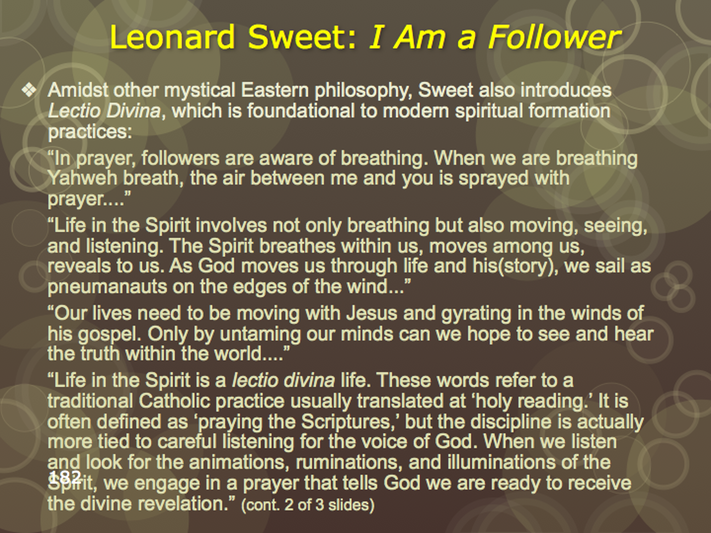
“What is the Lectio Divina? The word Lectio Divina is Latin for ‘divine reading,’ ‘spiritual reading,’ or ‘holy reading’ and represents a method of prayer and scriptural reading intended to promote communion with God and to provide special spiritual insights. The principles of lectio divina were expressed around the year A.D. 1620[?] and practiced by Catholic monks, especially the monastic rules of Sts. Pachomius, Augustine, Basil, and Benedict.
Today, this practice that has been kept alive in the tradition of Benedictine monastic’s and it’s not only popular among Catholics, it has gained acceptance in other faiths and, more recently, in the emerging church. Today it is better know as contemplative prayer. …
In order to practice lectio divina, select a time and place that is peaceful and in which you may be alert and prayerfully attentive. Dispose yourself for prayer in whatever way is natural for you. This may be a spoken prayer to God to open you more fully to the Spirit, a gentle relaxation process that focuses on breathing, singing or chanting, or simply a few minutes of silence to empty yourself of thoughts, images, and emotions. …
The Lectio Divina has the potential to become, and often does become a mystical experience pursuit in which the goal is to empty the mind and freely empower oneself unknown sub conscience powers . While the Christian’s often try justify the use of the Lectio Divina because of use Scriptures to pursue the knowledge of God, wisdom, and holiness in this prayer method. This however does not mean that the end justify the means.” (http://www.empoweredbychrist.org/-what-is-the-lectio-divina.html)
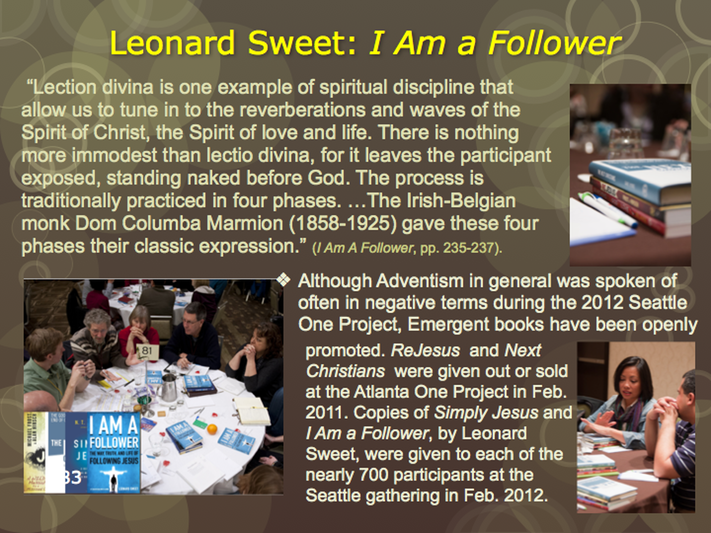
For more information: ReJesus: A Wild Messiah for a Missional Church, by Michael Frost and Alan Hirsch, see “The Emerging Church and The One Project?” presentation 5; The Next Christians: The Good News About the End of Christian America (2010), by Gabe Lyons, see presentation 5; Simply Jesus: A New Vision of Who He Was, What He Did, and Why He Matters (2006), by N. T. Wright, see presentation 6; I Am A Follower: The Way, Truth and Life of Following Jesus, (Jan. 2012), by Leonard Sweet, see presentation 4, at: http://thegreatcontroversy.info/power-point-presentations.html
Photos were found at:
(http://the1project.smugmug.com/Gatherings/Gatherings/22376237_dK9fpF#!i=1789197460&k=hjHT2KW)
(http://the1project.smugmug.com/Gatherings/Seattle/22409901_rhnMRf#!i=1795495386&k=BRm5Sbk&lb=1&s=XL)
(http://the1project.smugmug.com/Gatherings/Seattle/22409901_rhnMRf#!i=1795495417&k=66Hn5pw&lb=1&s=L)
(http://the1project.smugmug.com/Gatherings/Seattle/22409901_rhnMRf#!i=1795495401&k=Hbz6DV5)
(http://the1project.smugmug.com/Gatherings/Gatherings/22376237_dK9fpF#!i=1789197460&k=hjHT2KW)
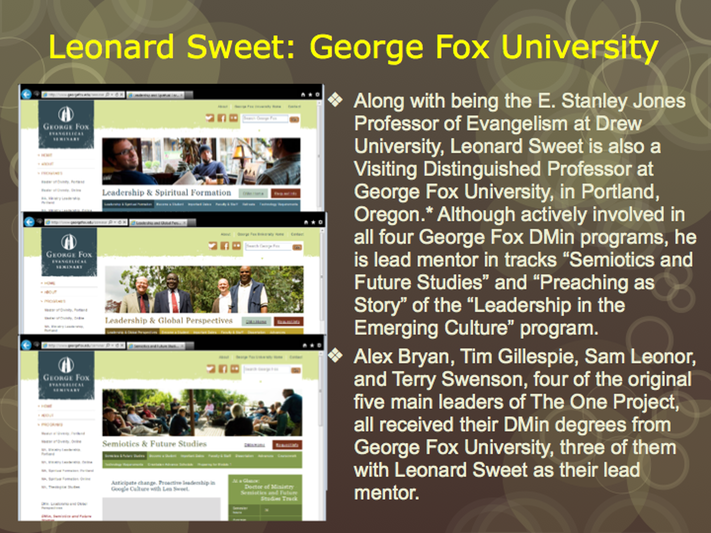
George Fox College was founded by Quakers in 1885 and is located in Newberg Oregon, and has centers in Portland, Salem and Boise, ID. In 1996, the college merged with Western Evangelical Seminary to form George Fox University. Notable graduates include Richard Foster, and Dan Kimball, both big names in Emerging Church movement. For more information on George Fox, see, “The Emerging Church and The One Project?” presentation 4; http://thegreatcontroversy.info/power-point-presentations.html
Doctor of Ministry
George Fox now offers 4 Doctor of Ministry programs:
DMin in Leadership and Spiritual Formation, with MaryKate Morse.
DMin in Leadership and Emerging Culture, with three tracks to choose from.
DMin in Leadership and Global Perspectives, with Jason Clark.
DMin in Semiotics and Future Studies, with Leonard Sweet.
DMin in Preaching as Story, with Leonard Sweet.
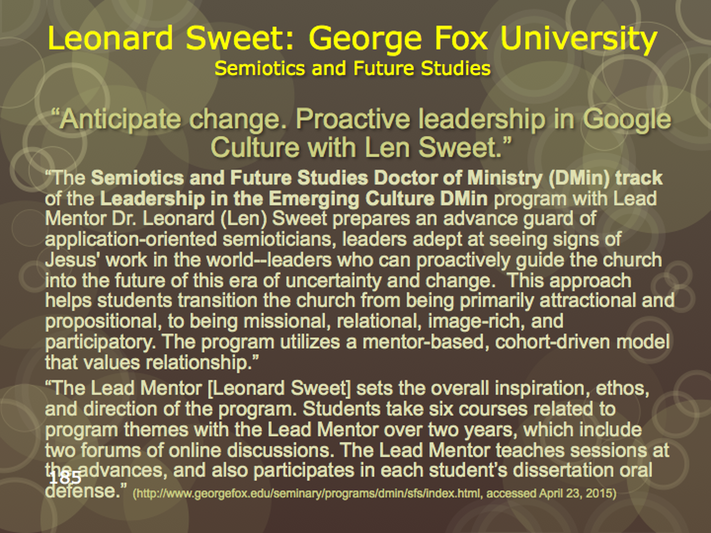
Definition of SEMIOTICS: “a general philosophical theory of signs and symbols.” Leonard Sweet has been the primary person to make this word popular in the Emerging Church movement. He states that he bases it on Matt 16:3 “He answered and said unto them, When it is evening, ye say, It will be fair weather: for the sky is red. And in the morning, It will be foul weather to day: for the sky is red and lowring. O ye hypocrites, ye can discern the face of the sky; but can ye not discern the signs of the times?” The Greek word is “sēmeion” which means: “an indication, especially ceremonially or supernaturally: - miracle, sign, token, wonder.” Sweet seems to use it as a term that describes himself and his cohorts and followers, who can see the signs in different religions, cultures and histories that can be a means of leading the Emerging Church of today.
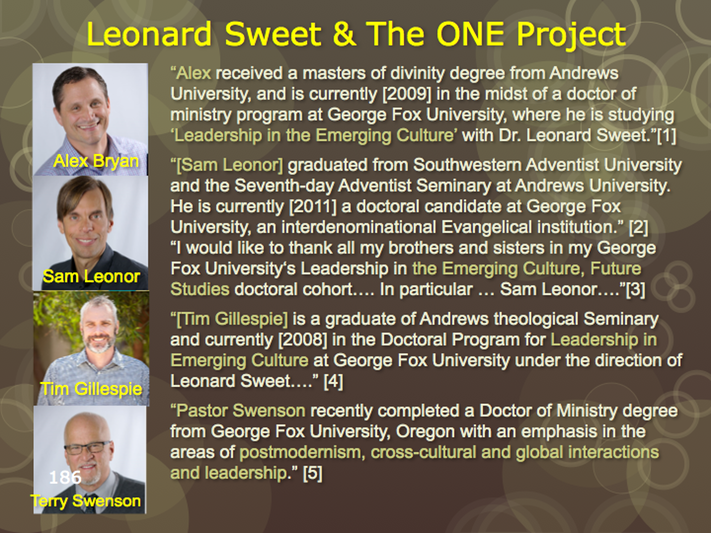
[1] Taken from Alex Bryan’s blog, Breakfast Fires (since removed). Can be viewed, however, at http://www.slideshare.net/EmergingOmega/spiritually-experiencing-god-part-2, slide 109.
[2] (http://www.atoday.org/article /1302/news/july-headlines/god-encounters-2012-conference-for-young-adults-will-feature-sam-leonor)
[3] (http://johncokeefe.com/John%20C%20OKeefe%20-%20Creatives.pdf)
[4] (http://www.adventpraise.org/article/65/artists/timothy-gillespie)
[5] (http://www.llu.edu/central/ chaplain/terry.page)
For a more in-depth analysis of the work of the five main organizers of The ONE Project, see PowerPoint presentations number 5 for Japhet De Oliveira; number 6 for Alex Bryan; number 7 for Sam Leonor; number 8 for Tim Gillespie; number 9 for Terry Swenson. All located at http://thegreatcontroversy.info/power-point-presentations.html
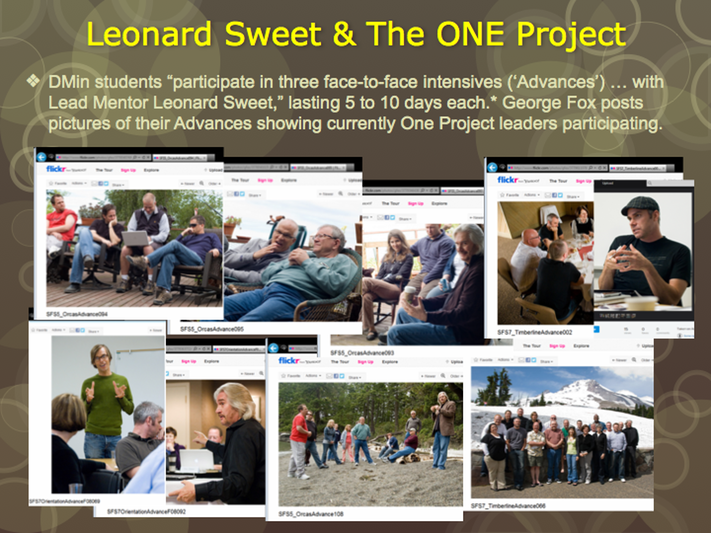
*(http://www.georgefox.edu/seminary/programs/dmin/sfs/index.html and
http://www.georgefox.edu/seminary/programs/dmin/sfs/advances.html, accessed April 23, 2015).
Photos:
https://www.flickr.com/photos/gfes/with/3784312945/
https://www.flickr.com/photos/gfes/with/3785106870/
https://www.flickr.com/photos/gfes/page71/
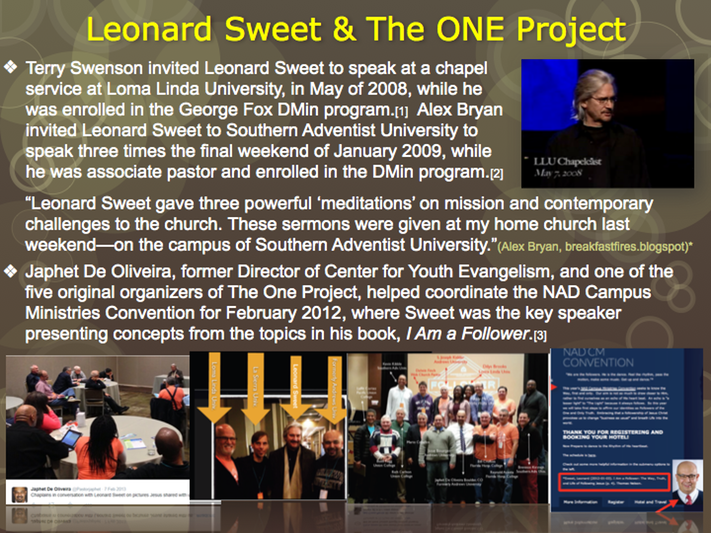
[1] (https://itunes.apple.com/us/itunes-u/may-7-2008-university-worship/id510736064?i=111564011)
[2] On Alex’s own blog for Feb. 3, 2009, he mentioned this event and even posted links to Sweet’s three sermons (“A Theology of Football”; “The Perfect Storm”; and “The Music of Life”). Only one of the sermons is still available on line, “A Theology of Football,” delivered Sabbath, Jan. 31, 2009. (https://www.box.com/shared/2xqso2joaf). *(Alex Bryan, www.breakfastfires.blogspot.com/2009_02_03_archive.com; since removed).
Some see no problem with Alex inviting Sweet Southern Adventist University because Sweet “has been an invited speaker at General Conference, North American Division, union conference, and local conference gatherings.” (http://www.scribd.com/doc/99405825/Response-to-the-Anonymous-Letter-1) But as we will see, several of the One Project leaders have played a part in inviting Sweet to our University campuses to introduce him and his books to our young people.
[3] https://twitter.com/hashtag/nadcmc?f=realtime&src=hash
http://www.slideshare.net/iALERT/04-the-emerging-church-and-the-one-project-part-4; slide 18, 21, 22.
Leonard Sweet had also been the key speaker at the 2011 retreat: “2011 NAD Adventist Campus Chaplains Conference: This years conference (March 20-22) was held in the Seattle, WA area at Rosario Beach Marine Laboratory retreat center for Walla Walla University. Chaplains from most of the Seventh-day Adventist colleges and universities in the North American Division were in attendance along with NAD Youth Director Elder James Black and Adventist Chaplaincy Ministries Larry Roth. Featured speaker Dr. Leonard Sweet shared keen insights on reading the bible as story. Important highlights from the committee included establishing the campus chaplains conference as a designated committee of the NAD with Chaplain Rich Carlson (Union College) as president of the officially recognized committee. The Campus Chaplains Conference meets every year on a rotating basis among all NAD Adventist colleges. Next years campus ministry convention and chaplains conference is scheduled for March 21-27 and will be hosted by Southern Adventist University.” (“News and Events: 2011 NAD Adventist Campus Chaplains Conference,” ACF Today [Adventist Christian Fellowship], April, 2011, pp. 1-2; at http://www.ar4cministries.org/ARC/ACF_TODAY_FOLDER_files/ACFT-4%3A11%20.pdf, accessed April 26, 2015).
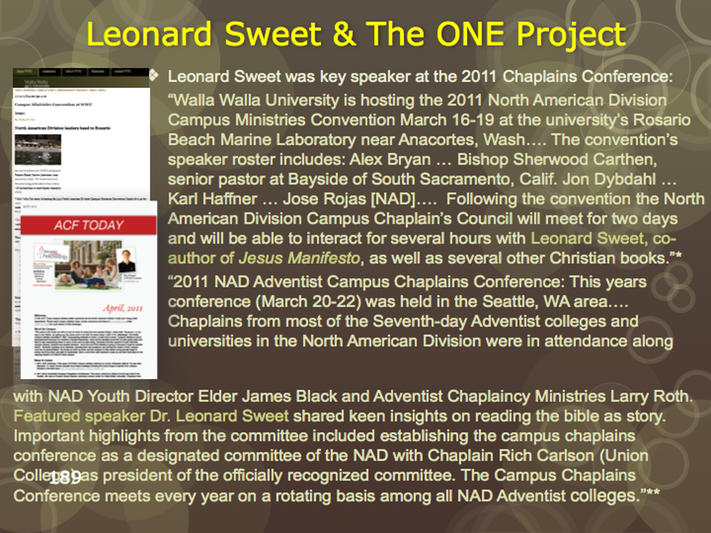
*(Becky St. Clair, “North American Division Leaders Head to Rosario,” Walla Walla University Web News, March 2, 2011; http://www.wallawalla.edu/academics/areas-of-study/undergraduate-programs/music/news/article/view/campus-ministries-convention-at-wwu/, accessed April 26, 2015)
**(“News and Events: 2011 NAD Adventist Campus Chaplains Conference,” ACF Today [Adventist Christian Fellowship], April, 2011, pp. 1-2; at http://www.ar4cministries.org/ARC/ACF_TODAY_FOLDER_files/ACFT-4%3A11%20.pdf, accessed April 26, 2015).
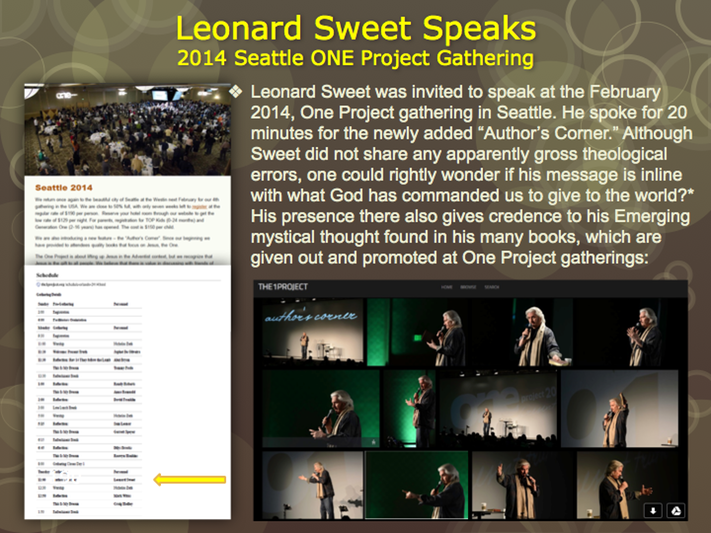
*”In a special sense Seventh-day Adventists have been set in the world as watchmen and light bearers. To them has been entrusted the last warning for a perishing world. On them is shining wonderful light from the word of God. They have been given a work of the most solemn import--the proclamation of the first, second, and third angels' messages. There is no other work of so great importance. They are to allow nothing else to absorb their attention.
“The most solemn truths ever entrusted to mortals have been given us to proclaim to the world. The proclamation of these truths is to be our work. The world is to be warned, and God's people are to be true to the trust committed to them. They are not to engage in speculation, neither are they to enter into business enterprises with unbelievers; for this would hinder them in their God-given work.” (Ellen G. White, Testimonies, vol. 9, p. 19).
The sound recording is 5:14 minutes long and taken from Sweet’s 20 minute talk.
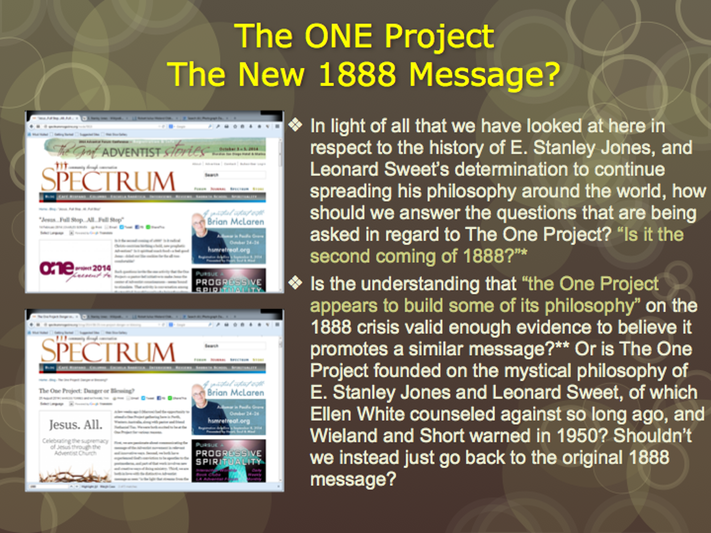
*(Charles Scriven, “Jesus...Full Stop...All...Full Stop,” Spectrum, Feb. 2014; http://spectrummagazine.org/node/5818)
**(Marcos Torres and Nathaniel Tan, “The One Project: Danger or Blessings?” Spectrum Blog, Aug 25, 2014; http://spectrummagazine.org/blog/2014/08/25/one-project-danger-or-blessing)
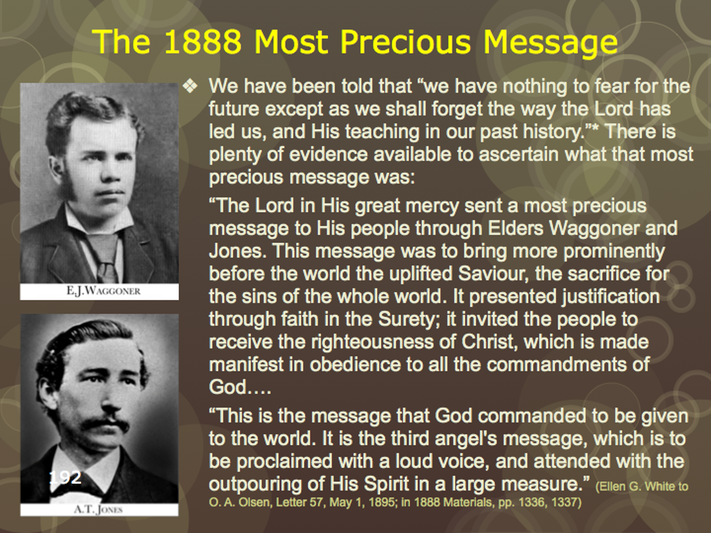
*(Ellen G. White, Testimonies to Ministers, p. 32)
“Both Jones and Waggoner were prolific writers of books and articles for the church papers. We know from their writings what they taught before the Conference, including Waggoner’s The Gospel in Galatians, written in 1887, which was given to the delegates attending the 1888 Conference. We also know from their writings what they taught after the Conference, including Waggoner’s Christ and His Righteousness, published in 1890, which was based on shorthand notes taken by Jessie F. Moser-Waggoner of E. J. Waggoner’s presentations at the 1888 General Conference.
“We also have available more than 1800 pages of Ellen White’s correspondence, manuscripts, and sermons regarding the Minneapolis episode as found in the four volumes of The Ellen G. White 1888 Materials. Added to that is Manuscripts and Memories of Minneapolis; nearly 600 pages of letters from various participants regarding the 1888 meetings. Included in this collection are copies of denominational and newspaper reports, such as the 1888 General Conference Daily Bulletin, R. Dewitt Hottel’s diary and two W. C. White notebooks containing notes written during meetings.
“The best summaries of the train of events, and of the content of Waggoner’s message at Minneapolis itself, can be found in: Clinton Wahlen, Selected Aspects of Ellet J. Waggoner’s Eschatology and Their Relation to His Understanding of righteousness by Faith, 1882-1895; and Paul E. Penno, Calvary at Sinai: The Law and the Covenants in Seventh-Day Adventist History.“ (Ron Duffield, The Return of the Latter Rain, pp. 107, 122)
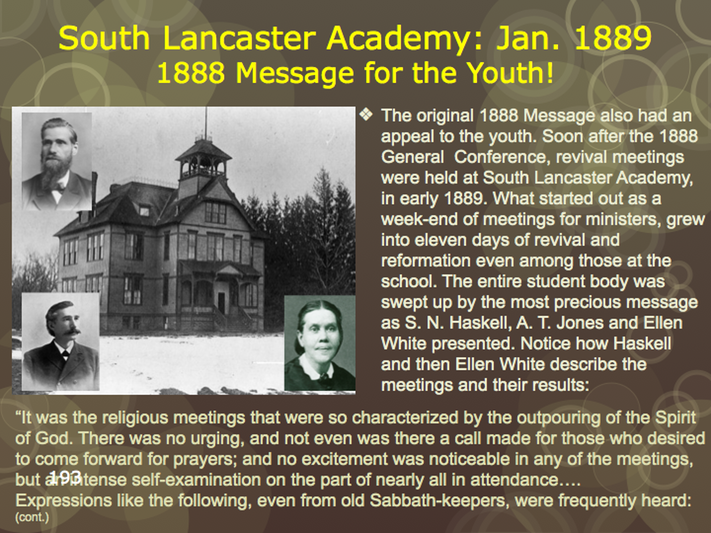
1 of 3 Slides.
For a more on the revivals that took place under the beginning of the loud cry and latter rain of the 1888 message, see: Ron Duffield, The Return of the Latter Rain, and Wounded in the House of His Friends, available at Amazon.com. And for a free audiobook, see: http://ellenwhiteaudio.org/pioneers/modern-works/the-return-of-the-latter-rain/; and http://ellenwhiteaudio.org/pioneers/modern-works/wounded-in-the-house-of-his-friends/.
For a presentation from ASI 2014, see: https://www.audioverse.org/english/sermons/recordings/6351/history-of-gods-intervention-to-bring-the-latter-rain.html
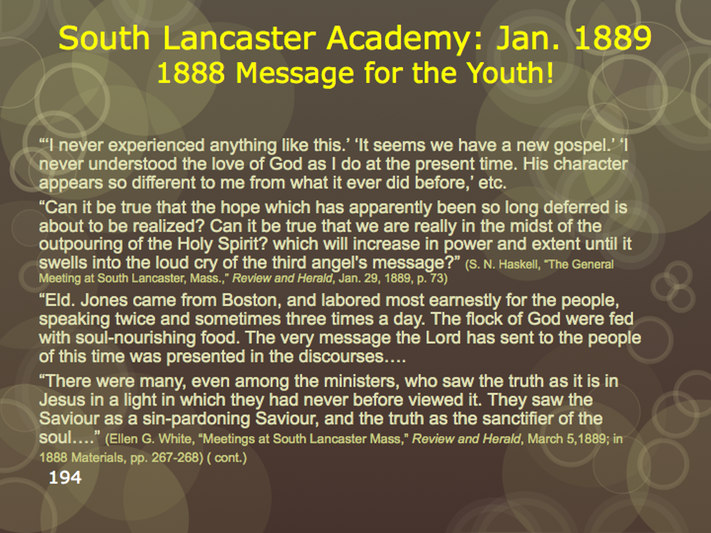
2 of 3 Slides.
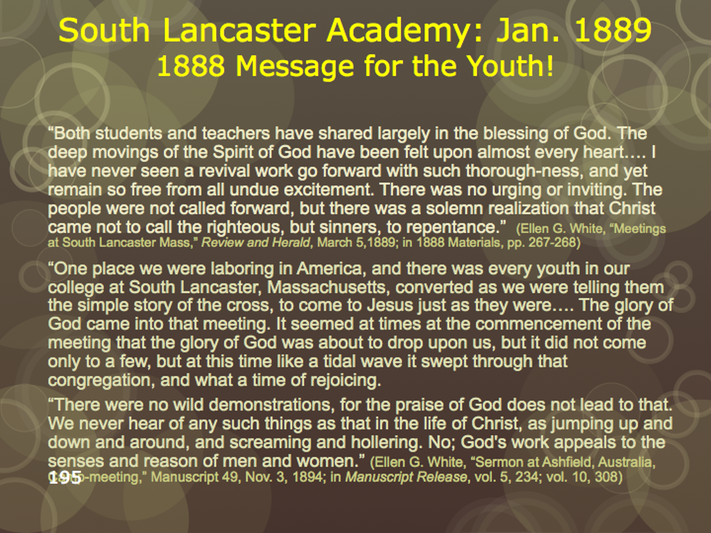
3 of 3 Slides.
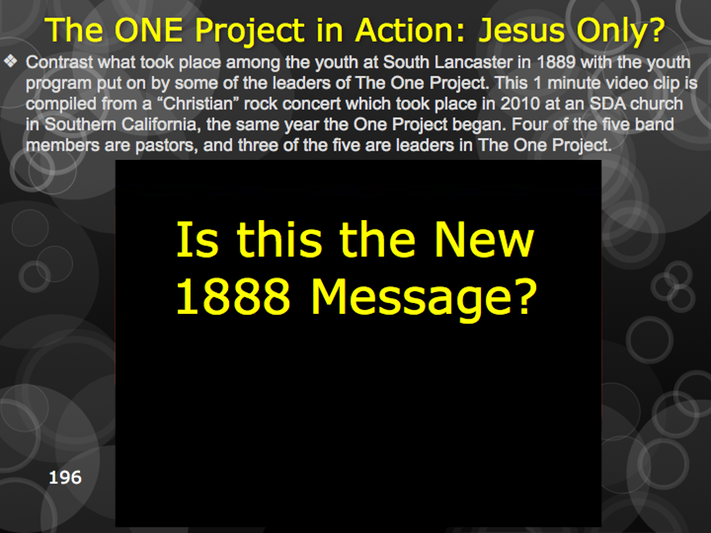
At that time:
Roy Ice (drums/vocals) Associate Pastor and College Chaplain at Pacific Union College;
Sam Leonor (bass/vocals) Pastor at La Sierra University;
Tim Gillespie (vocals), Youth Pastor at Loma Linda University, ReLive Church service.
Michael Knecht (guitars) Pastor at Crosswalk SDA Church in Redlands, CA;
Jason Hutchinson (guitars) from ReLive Church Praise Band where Tim Gillespie pastored.
For more information on The One Project, see: Ron Duffield, “The Emerging One Project?” PowerPoint presentations 1 through 10, at www.slideshare.com/ronduff
For more videos like the above used in the PowerPoint presentations, see: http://www.youtube.com/channel/UC-rFyZQ7Xecu-43P6Ut-5pw
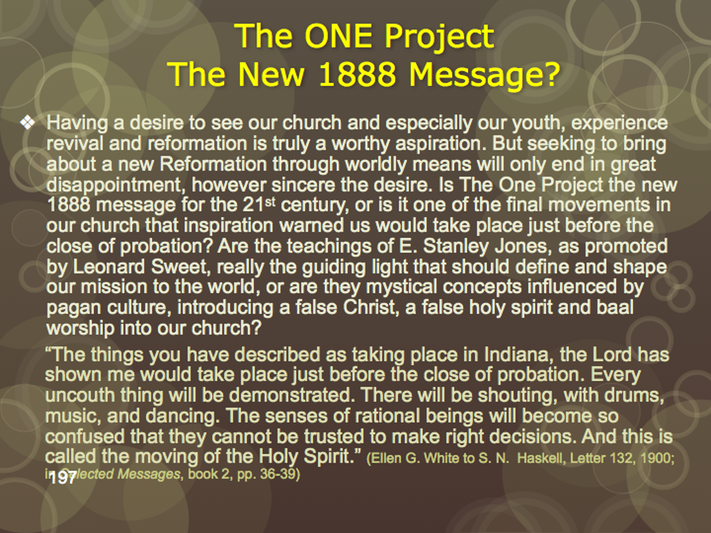
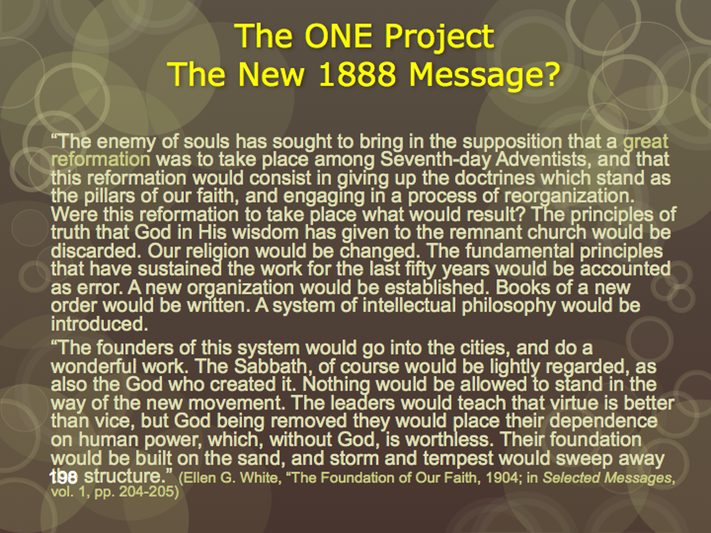
Is the One Project really the reformation that we need in our church (we do need one)? Based on the backgrounds of the Project leaders what will be the result of the influence of this Project on our young people through our Universities? The real Revival and Reformation will only come to us as we listen to, and take the advice of, the True Witness in Revelation chapter 3; Who is calling us to repent and then exchange our poverty for His gold, our nakedness for His robe of righteousness, our blindness for His eye-salve.
Comments and suggestions can be submitted to Ron Duffield at theemergingoneproject@gmail.com or returnofthelatterrain@gmail.com.